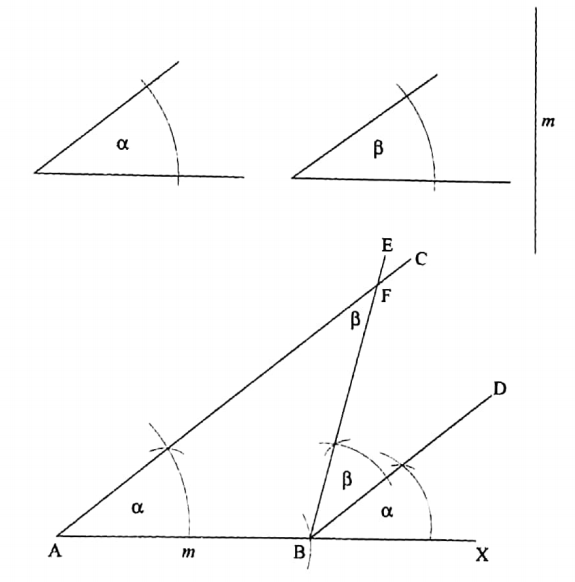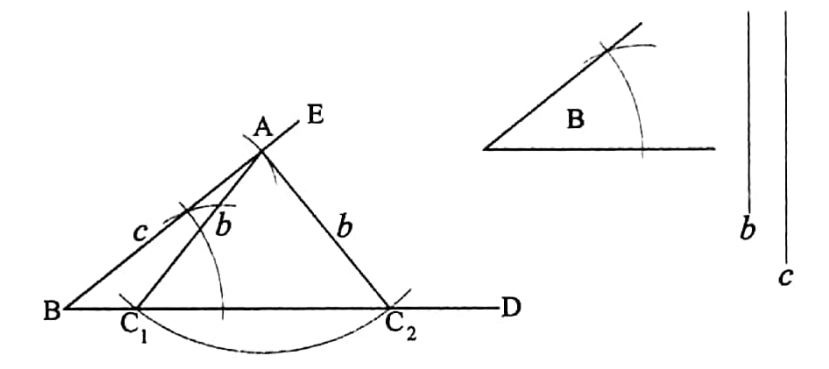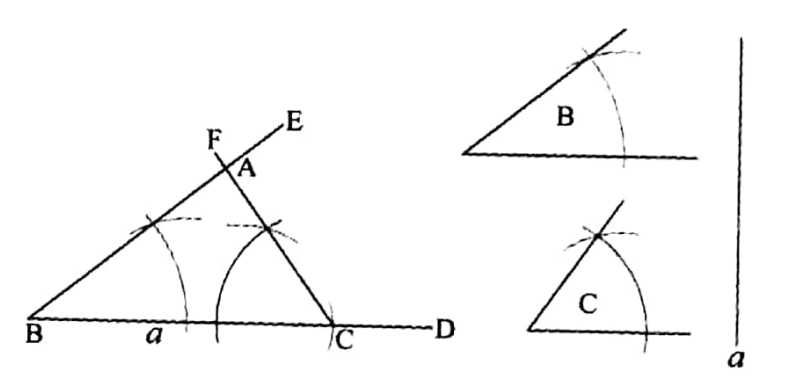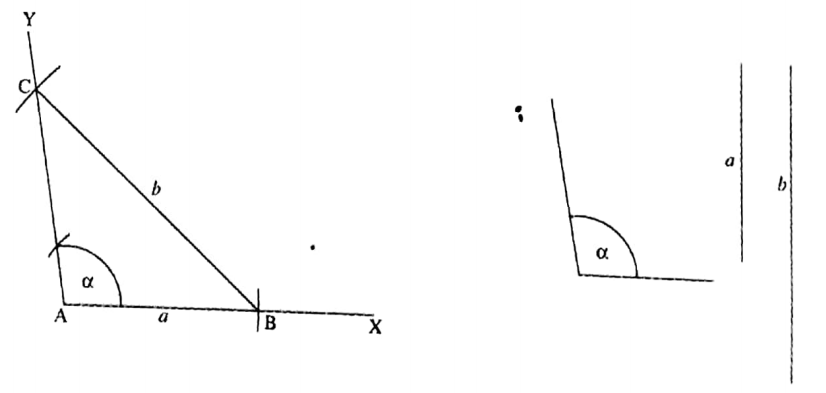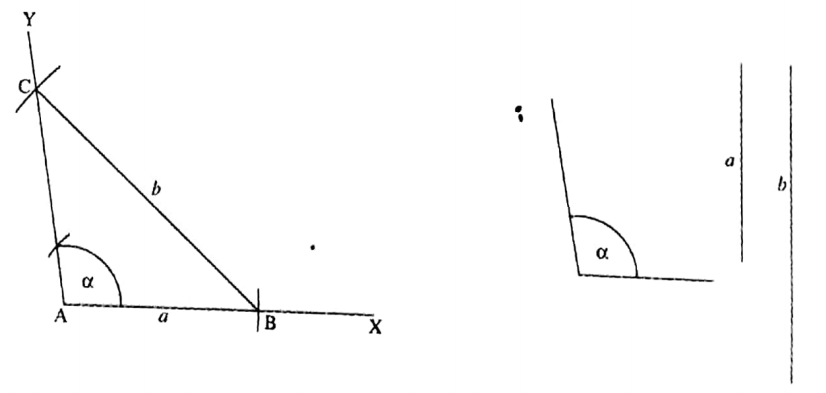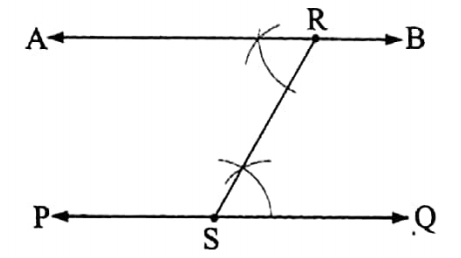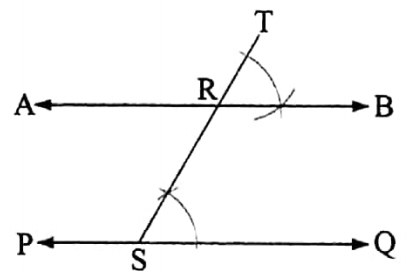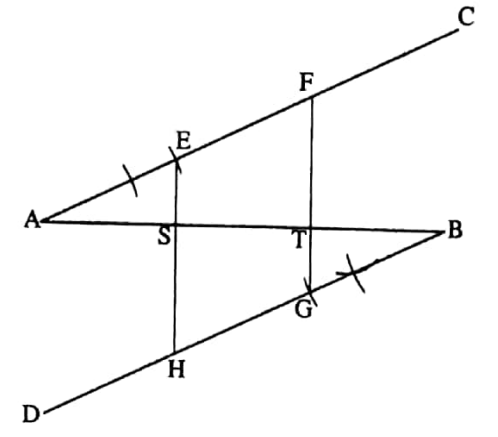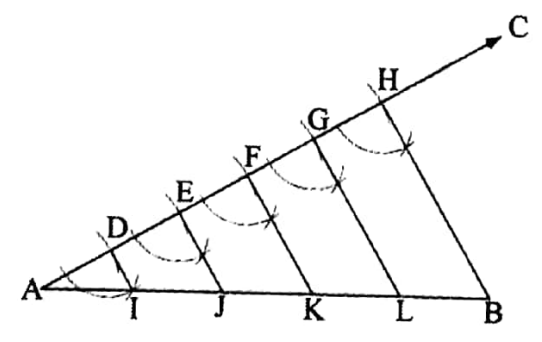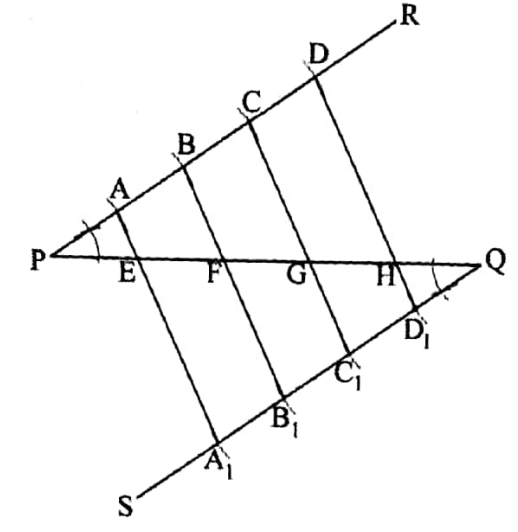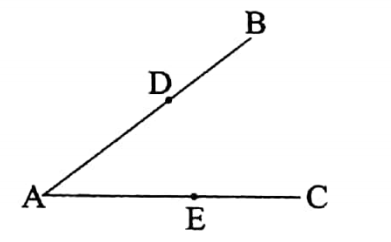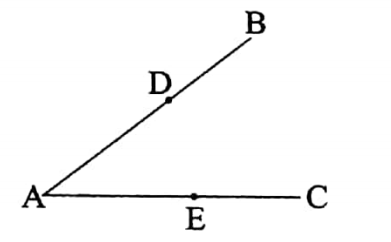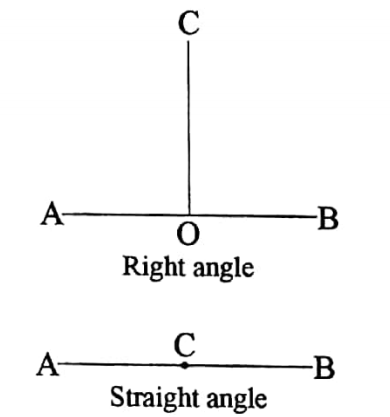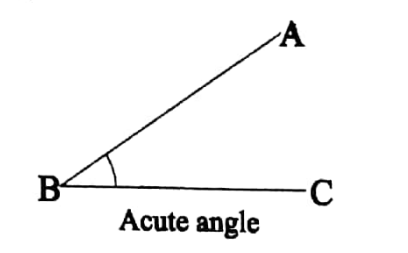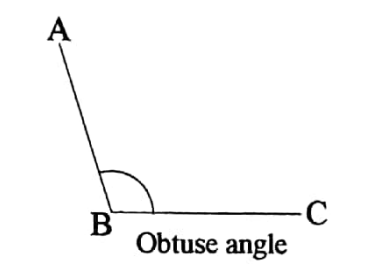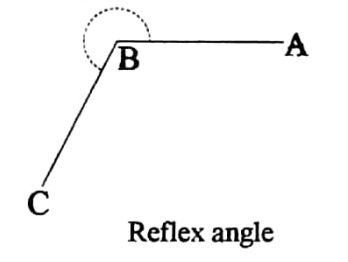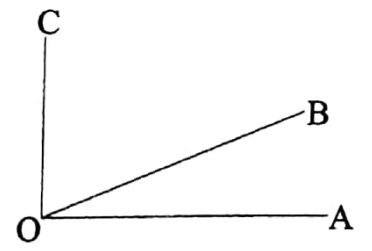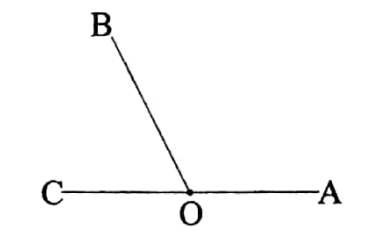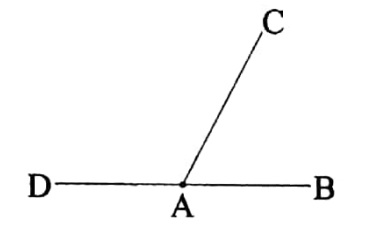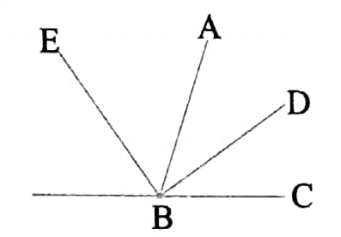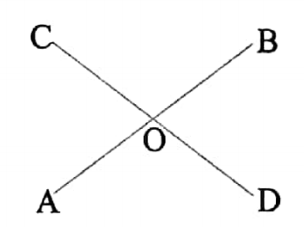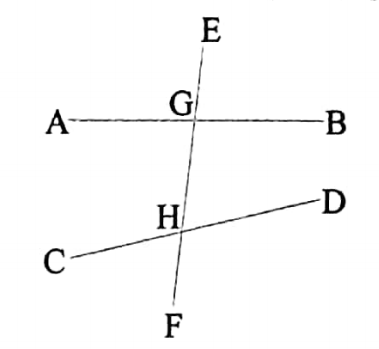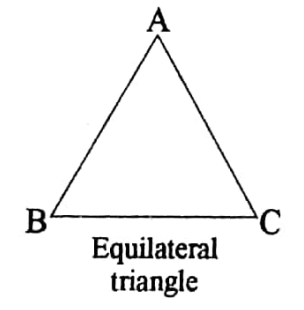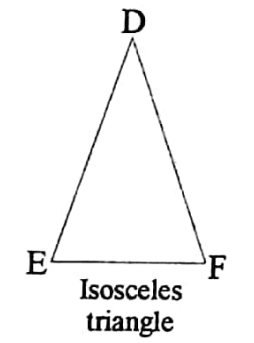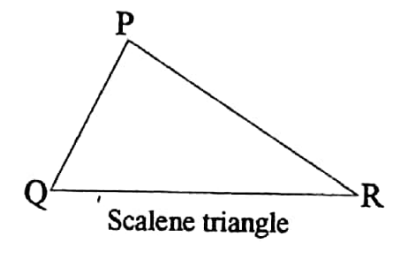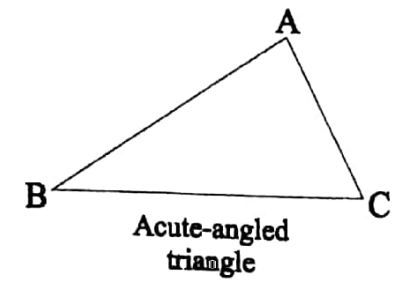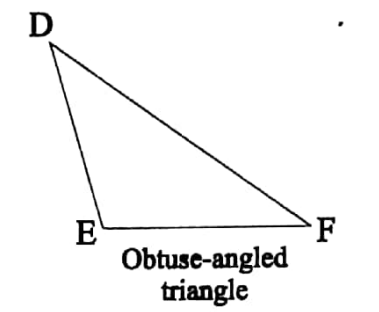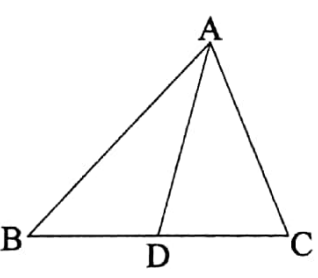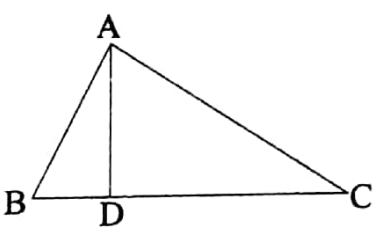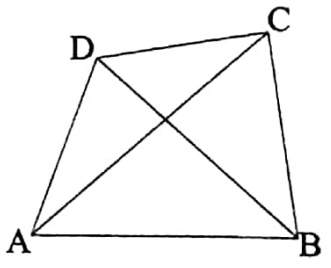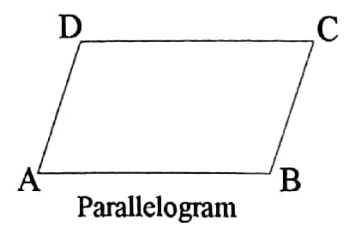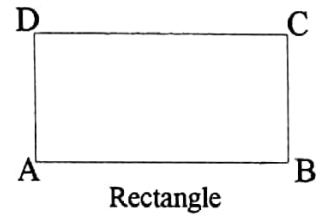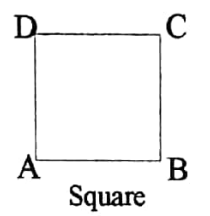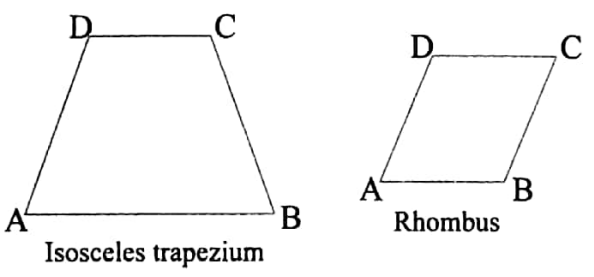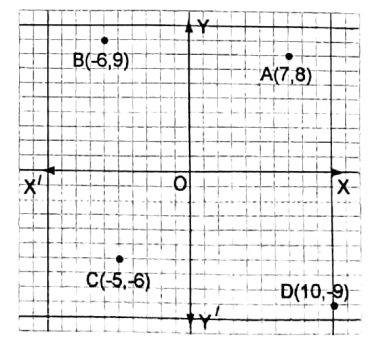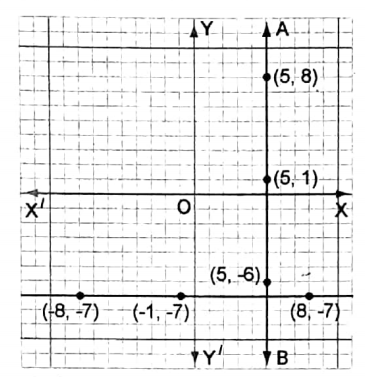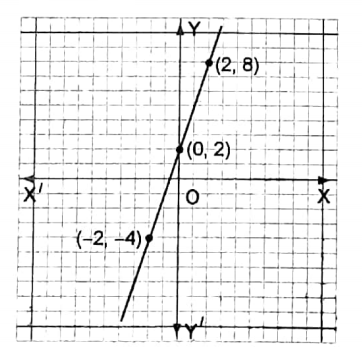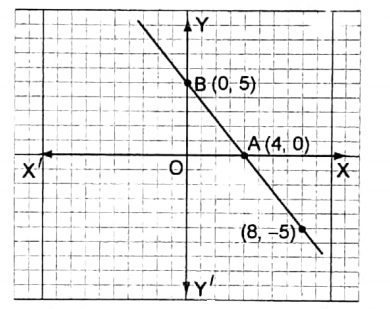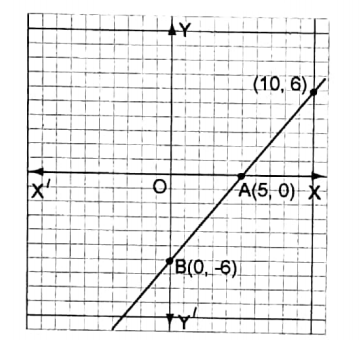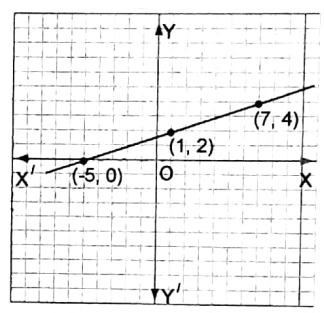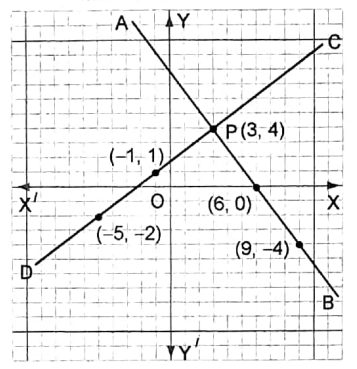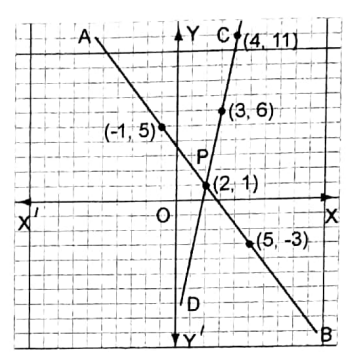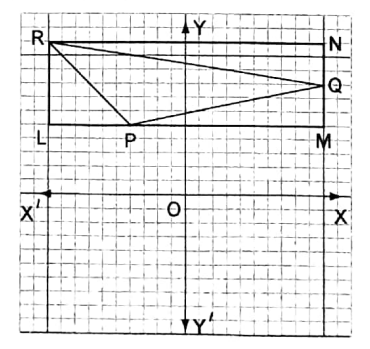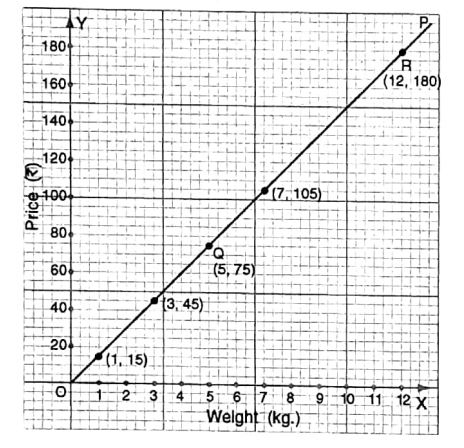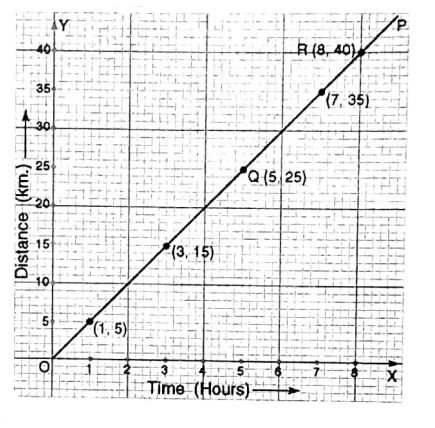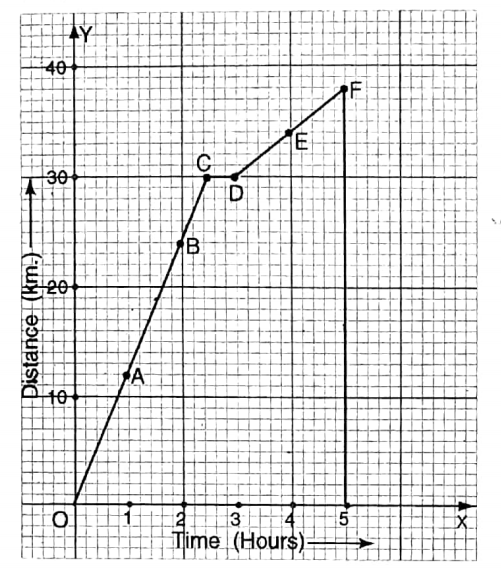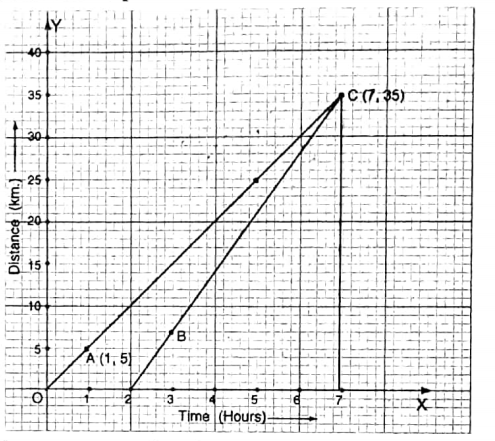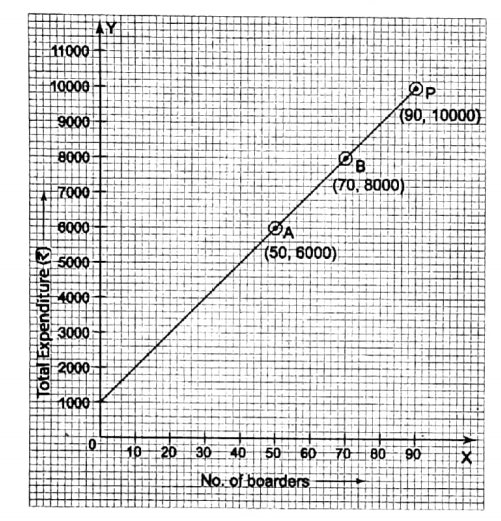Geometry Chapter 2 Theorems
Theorems Introduction
In geometry, we obtain some properties through activities. These properties are called axioms or self-evident truths. We need not establish an axiom with the help of reasoning. On the other hand, there are also some geometrical properties that can be established with the help of reasoning. When we prove any geometrical property with logic then the property to be proved, the method of proof, and arriving at the conclusion- all stages taken as a whole is called a theorem. Thus, a geometrical property along with a proof is a theorem.
Maths Solutions Class 8 Wbbse
Propositions
By propositions, we mean the statements which propose to prove some geometrical property or to perform some geometrical construction. There are two kinds of propositions namely Theorems and Problems.
Theorem: A proposition that is proved with logic is called a Theorem.
Problem: A proposition in which some geometrical construction is performed is called a Problem.
Different parts of a proposition
A geometrical proposition has four parts :
1. General Enunciation
2. Particular Enunciation
3. Construction and
4. Proof.
1. General enunciation: The general statement of the hypothesis and the conclusion is called the general enunciation.
2. Particular enunciation: The second part of a proposition is particular enunciation. A figure is drawn according to the general enunciation. The statement of hypothesis and conclusion according to the naming of the figure is called particular enunciation.
3. Construction: It may be necessary to have some construction for the proof of the proposition. In this part, the statement of such construction is mentioned.
4. Proof: This is the final part of the proposition. In this part, the proposition is proved through a strict sequence of reasoning.
Read And Learn More WBBSE Solutions For Class 8 Maths
Converse theorem
If two theorems be such that the hypothesis of the first is the conclusion of the second and the conclusion of the first is the hypothesis of the second then those theorems are said to be converse to each other.
Corollary
If from the conclusion of a theorem, some other conclusion readily follows then it is called a corollary.

Theorem 1
If a straight line stands on another ‘straight line, the sum of the two angles so formed is equal to two right angles.
Given:
A straight line stands on another ‘straight line, the sum of the two angles so formed is equal to two right angles.
Let \(\overleftrightarrow{A B}\) be a straight line.
\(\overrightarrow{O C}\) is another straight line that stands on AB at point O, forming the angle ∠BOC and ∠COA.
It is required to prove that, ∠BOC + ∠COA = 2 right angles.
Construction: Draw a straight line \(\overrightarrow{O D}\) perpendicular to AB at point O.
Proof : ∠BOC +∠COA =∠BOC ∠COD +∠DOA = ∠BOD +∠DOA
= 1 right angle + 1 right angle
= 2 right angles.
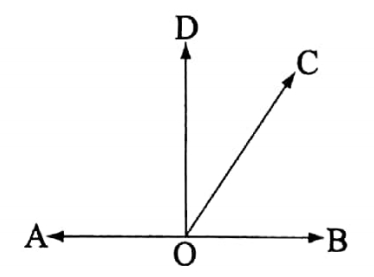
Verification of Theorem-1 :
Let \(\overleftrightarrow{A B}\) be a straight line.
\(\overrightarrow{O C}\) is another straight line that stands on
\(\overleftrightarrow{A B}\) at point O, forming the angles ∠BOC and ∠COA.
It is to be verified that ∠BOC + ∠COA = 2 right angles.
Fold the straight line \(\overleftrightarrow{A B}\) at point O in such a way that \(\overrightarrow{O A}\) coincides with In this case the line of fold is \(\overrightarrow{O D}\).
It is clear that \(\overrightarrow{O D}\) is perpendicular to \(\overleftrightarrow{A B}\).
Measuring with a protractor it is found that,
∠BOD = 90° =∠DOA.
It means that the measure of each of the angles ∠BOD and ∠DOA is equal to 1 right angle.
Now, ∠BOC + ∠COA = ∠BOC + ∠COD ∠ DOA
= ∠BOD + ∠DOA
= 90° + 90°
= 180°
= 2 right angles.
Maths Solutions Class 8 Wbbse
Theorem 2
If the sum of two adjacent angles is equal to two right angles, the exterior arms of the angles lie in the same straight line.
Given:
The sum of two adjacent angles is equal to two right angles, the exterior arms of the angles lie in the same straight line.
Let the sum of two adjacent angles ∠COB and ∠COA be equal to two right angles. The exterior arms of these two
adjacent angles are \(\overrightarrow{O B}\) and \(
\overrightarrow{O A}
\).
It is required to prove that \(\overrightarrow{O B}\) and \(
\overrightarrow{O A}
\). lie on the same straight line.
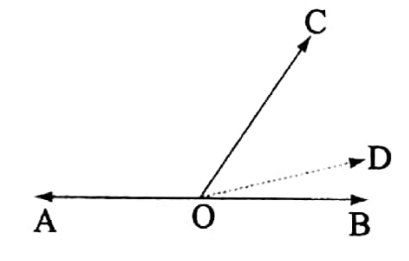
Proof: Let, \(
\overrightarrow{O B}
\)., and \(
\overrightarrow{O A}
\). are not on the same straight line.
Then \(
\overrightarrow{O A}
\). produced must pass through some other straight-line \(
\overrightarrow{O D}
\).
Now, since the straight-line \(
\overrightarrow{O C}
\). stands on the straight-line \(\overleftrightarrow{A B}\),
∠COD + ∠COA = 2 right angles.
Also by hypothesis, ∠COB + ∠COA = 2 right angles.
Hence, ∠COD + ∠COA =∠COB +∠COA
or, ∠COD = ∠COB
So, \(
\overrightarrow{O D}
\). coincides with \(
\overrightarrow{O D}
\).
Thus, our assumption that \(
\overrightarrow{O B}
\). and \(
\overrightarrow{O A}
\). are not on the same straight line is wrong.
Hence, \(
\overrightarrow{O B}
\). and \(
\overrightarrow{O A}
\). lie in the same straight line.
Understanding Basic Geometry Theorems
Verification of Theorem-2 :
Draw any straight line \(
\overrightarrow{O B}
\). With the help of a protractor draw an angle ∠BOC = 45°.
Again, with the help of the protractor draw another angle ∠COA = 135°.
Therefore,∠BOC +∠COA
= 45° + 135°
= 180°.
If a ruler is placed along the arm \(
\overrightarrow{O B}
\). of the angle ∠BOC then it is found that
\(
\overrightarrow{O A}
\). and \(
\overrightarrow{O B}
\). lie on the same straight line.
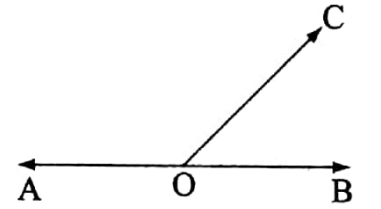
Some Examples
Example 1
Prove that the sum of the four angles, formed by the intersection of two straight lines, is equal to four right angles.
Solution :
Given:
The sum of the four angles, formed by the intersection of two straight lines, is equal to four right angles.
Let \(\overleftrightarrow{A B}\) and \(\overleftrightarrow{C D}\) be the two straight lines that intersect each other at point 0.
As a result of the intersection of these two straight lines, the four angles ∠BOC, ∠COA, ∠AOD, and∠DOB have been formed.
It is required to prove that :
∠BOC +∠COA + ∠AOD +∠DOB = 4 right angles.
Proof: Since \(\overrightarrow{O C}\)stands on the straight
line \(\overleftrightarrow{A B}\)at the point O therefore, ∠BOC + ∠COA = 2 right angles …….. (1)
Also since \(\overrightarrow{O D}\)stands on the straight
line AB at the point O therefore, ∠AOD + ∠DOB = 2 right angles …….. (2)
Adding (1) and (2) we get,
∠BOC + ∠COA +∠AOD + ∠DOB = 4 right angles.
Example 2
Prove that the angle between the internal and the external bisector of an angle is equal to one right angle.
Solution :
Given:
The angle between the internal and the external bisector of an angle is equal to one right angle.
Let ∠ABC be an angle whose internal bisector is \(\overrightarrow{B D}\) and whose external bisector is \(\overrightarrow{B E}\).
It is required to prove that: ∠DBE = 1 right angle
Proof: Since \(\overrightarrow{B D}\) is the bisector of ∠ABC,
:. ∠ABD = 1/2 ∠ABC …….. (1)
Also, since \(\overrightarrow{B E}\) is the bisector of ∠ABF,
∠ABE = 1/2 ∠ABF …….. (2)
Adding (1) and (2) we get,
∠ABD + ∠ABE = 1/2 (∠ABC +∠ABF)
= 1/2 x 180° = 90°
or, ∠DBE = 1 right angle.
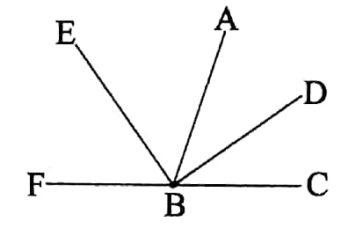
Example 3
Prove that, if the angle formed by the bisectors of two adjacent angles is equal to 1 right angle, then the exterior sides of the adjacent angles will be on the same straight line.
Solution :
Given:
The angle formed by the bisectors of two adjacent angles is equal to 1 right angle, then the exterior sides of the adjacent angles will be on the same straight line.
Let ∠ABC and∠ABF be two adjacent angles.
\(\overrightarrow{B D}\) is the bisector of ∠ABC and \(\overrightarrow{B E}\) is the bisector of ∠ABF.
It is given that ∠DBE = 1 right angle.
It is required to prove that: BC and BF lie on the same straight line.
Proof: ∠ABC = 2∠ABD……. (1)
and ∠ABF = 2∠ABE…….. (2)
Adding (1) and (2) we get,
∠ABC + ∠ABF = 2 ∠ABD +∠ABE) = 2 x ∠DBE
= 2 x 1 right angle
= 2 right angles.
Hence, BC and BF lie in the same straight line.
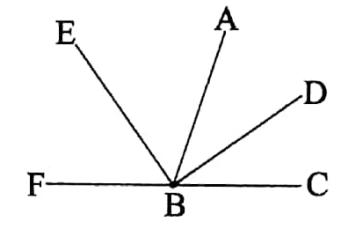
Example 4
Prove that, if some straight lines stand on another straight line then the sum of the consecutive angles is equal to two right angles.
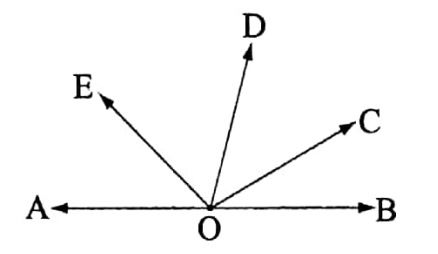
Solution :
Given:
Some straight lines stand on another straight line then the sum of the consecutive angles is equal to two right angles.
Let \(\overleftrightarrow{A B}\) be a straight line. \(\overrightarrow{O C}\), \(\overrightarrow{O D}\), and \(\overrightarrow{O E}\) be the straight lines standing on \(\overleftrightarrow{A B}\).
It is required to prove that: ∠BOC + ∠COD +∠DOE + ∠EOA = 2 right angles.
Proof: Since \(\overrightarrow{O C}\) stands on \(\overrightarrow{A B}\)
∠BOC + ∠COA = 2 right angles.
or, ∠BOC + ∠COD +∠DOE +∠EOA = 2 right angles.
Example 5
Prove that, the sum of the consecutive angles formed by some straight lines emerging from a point is equal to four right angles.
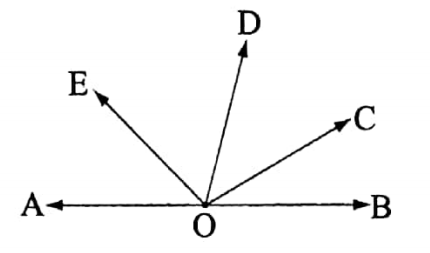
Solution:
Given:
The sum of the consecutive angles formed by some straight lines emerging from a point is equal to four right angles.
Let O be a fixed point.
\(\overrightarrow{O A}\), \(\overrightarrow{O B}\), \(\overrightarrow{O C}\), \(\overrightarrow{O D}\), \(\overrightarrow{O E}\), \(\overrightarrow{O F}\) be straight lines emerging from point O.
It is required to prove: ∠AOB + ∠BOC +∠COD + ∠DOE + ∠EOF +∠FOA = 4 right angles.
Construction: Produce AO to point A’.
Proof: Since A’OA is a straight line, therefore,
∠AOB +∠BOC + ∠COA = 2 right angles …. (1)
and ∠AOD + ∠DOE + ∠EOF + ∠FOA = 2 right angles …. (2)
Adding (1) and (2) we get,
∠AOB + ∠BOC + ∠COA ∠ AOD + ∠DOE + ∠EOF + ∠FOA = 4 right angles
or, ∠AOB +∠BOC + ∠COD + ∠DOE + ∠EOF + ∠FOA = 4 right angles.
Example 6
Prove that, if two straight lines intersect at a point then the bisectors of the four angles are two mutually perpendicular straight lines.
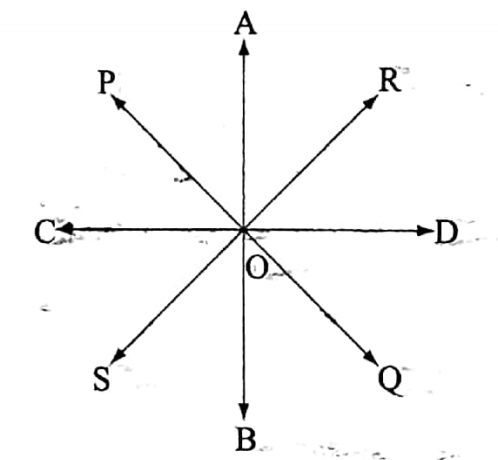
Solution:
Given:
The sum of the consecutive angles formed by some straight lines emerging from a point is equal to four right angles.
Let the two straight lines \(\overleftrightarrow{P Q}\) intersect at point O.
Let, \(\overrightarrow{O A}\), \(\overrightarrow{O C}\), and \(\overrightarrow{O B}\) be the bisectors of the angles ∠POR ∠POS, ∠SOQ, and ∠ROQ respectively.
It is required to prove that \(\overline{A O B}\)and \(\overline{C O D}\) are two mutually perpendicular straight lines.
Proof: Since \(\overrightarrow{O A}\), \(\overrightarrow{O C}\), \(\overrightarrow{O B}\), and \(\overrightarrow{O D}\) are respectively the bisectors of the angles ∠POR, ∠EOS, ∠SOQ, and ∠ROQ
∴∠AOP = 1/2 ∠POR …(1)
∠POC = 1/2 ∠POS… (2)
Adding (1) and (2) we get,
∠AOP + ∠POC = 1/2 ∠FOR +∠POS)
or, ∠AOC = 1/2 x 2 right angles = 1 right angle.
Similarly, ∠COB – ∠BOD = ∠DOA – 1 right angle
∠AOC + ∠COB = 1 right angle + 1 right angle = 2 right angles.
\(\overrightarrow{O A}\) and \(\overrightarrow{O B}\) are in the same straight line.
Similarly, \(\overrightarrow{O C}\) and \(\overrightarrow{O D}\) are in the same straight line.
Hence, \(\overline{A O B}\) and \(\overline{C O D}\) are two mutually perpendicular straight lines.
Example 7
From the figure shown below find the value of x.
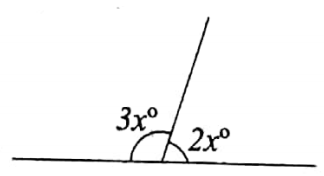
Solution:
From the given
2xº + 3xº = 180º
or, 2x + 3x = 180
or, 5x = 180
or, x = 180/5
= 36
The value of x is 36.

Example 8
Draw any straight line \(\overleftrightarrow{X Y}\). Take any two points A and B on it. At A draw any straight line \(\overrightarrow{A C}\). At B draw the straight line \(\overrightarrow{B D}\) such that ∠ABD = ∠YAC.
Show that: ∠CAB = ∠DBX.
Solution:
Any straight fine \(\overleftrightarrow{X Y}\) is drawn. A and B
are any two points on \(\overleftrightarrow{X Y}\). At point A,
any straight line \(\overrightarrow{A C}\) is drawn. Now the
straight line \(\overrightarrow{B D}\) is drawn in such a way
that ∠ABD = ∠YAC.
It is required to prove that, ∠CAB = ∠DBX.
Proof: Since \(\overrightarrow{A C}\), stands on \(\overleftrightarrow{X Y}\)
therefore, ∠YAC. + ∠CAB = 180°… (1)
Also since BD stands on \(\overleftrightarrow{X Y}\)
therefore, ∠ABD + ∠DBX = 180° …. (2)
From (1) and (2)
∠YAC + ∠CAB = ∠ABD + ∠DBX
Since ∠ABD =∠YAC
∴ ∠CAB =∠DBX.
Theorem 3
If two straight lines intersect, the vertically opposite angles are equal.
Let \(\overleftrightarrow{A B}\) and \(\overleftrightarrow{O D}\) be any two straight lines that intersect at O.
It is required to prove that :
1. ∠AOD= vertically opposite
2. ∠AOC =vertically opposite
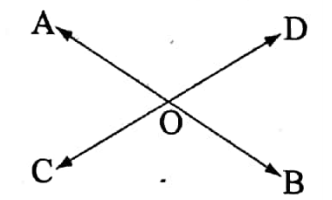
Proof: Since \(\overrightarrow{O D}\) stands on \(\overleftrightarrow{A B}\) therefore,
∠AOD ∠DOB = 2 right angles … (1)
Also since \(\overrightarrow{O B}\) stands on \(\overrightarrow{C D}\)therefore,
∠DOB +∠BOC = 2 right angles …. (2)
From (1) and (2) we get,
∠AOD + ∠DOB = ∠DOB + ∠BOC
or, ∠AOD = ∠BOC.
Also since \(\overrightarrow{O A}\) stands on \(\overrightarrow{C D}\) therefore,
∠AOC +∠AOD = 2 right angles …. (3)
and \(\overrightarrow{O D}\) stands on \(\overleftrightarrow{A B}\) therefore,
∠AOD +∠DOB = 2 right angles …. (4)
From (3) and (4) we get,
∠AOC + ∠AOD = ∠AOD + ∠DOB
:. ∠AOC =∠DOB.
Verification of Theorem-3 :
Draw any two straight lines\(\overleftrightarrow{A B}\) and
\(\overleftrightarrow{C D}\)on your paper. Let the point of intersection of \(\overleftrightarrow{A B}\) and \(\overleftrightarrow{C D}\) be 0.
Measuring with a protractor you will find that ∠AOD = ∠BOC and ∠AOC = ∠BOD.
Some Examples
Example 1
The two straight lines \(\overleftrightarrow{A B}\) and \(\overleftrightarrow{C D}\) intersect at 0. If ∠AOC = 55° then find the measures of the angles ∠AOD, ∠BOD, and∠BOC.
Solution :
Given:
The two straight lines \(\overleftrightarrow{A B}\) and \(\overleftrightarrow{C D}\) intersect at 0. If ∠AOC = 55°
Since, ∠AOC = 55° therefore,∠BOD = 55°.
Again, ∠AOD = 180° – ∠AOC
= 180° – 55° = 125°
.-. ∠BOC = 125°
∠AOD = 125°,∠BOD = 55° and ∠BOC = 125°.
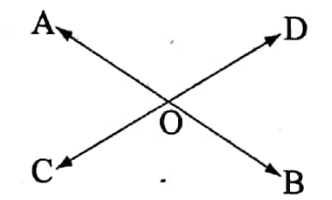
Example 2
Two straight lines intersect each other at a point. The sum of the three angles, out of the four angles thus formed is 315°. Find the measures of the four angles formed at that point.
Solution :
Given:
Two straight lines intersect each other at a point. The sum of the three angles, out of the four angles thus formed is 315°.
Since the sum of the three angles is 315°, therefore the measure of the fourth angle
= 360° – 315°
= 45°.
Therefore, its vertically opposite angle is also 45°.
Hence, the sum of the other two angles is 360° – 2 x 45°
= 360° – 90°
= 270°
∴ The measure of each of them
= 270º / 2
= 135°
The Measures of the angles formed at that point are 45°, 45°, 135° and 135°.
Example 3
Find the measure of the angle ∠BOC from the figure shown below.
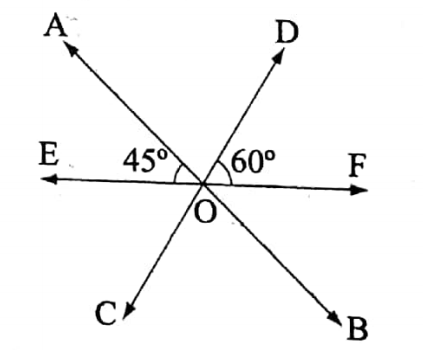
Here \(\overleftrightarrow{E F}\) is a straight line. Hence,
∠AOE + ∠AOD + ∠DOF = 180°
or, 45° ∠AOD + 60° = 180°
or, ∠AOD + 105° = 180°
or, ∠AOD = 180° – 105° = 75°
∴∠BOC = ∠AOD = 75°
Example 4
\(\overleftrightarrow{A B}\) is a straight line and O is a point on it. From 0. two straight lines \(\overrightarrow{O C}\) and \(\overrightarrow{O D}\)are drawn on the opposite sides of \(\overrightarrow{A B}\). If ∠AOC = ∠BOD then prove that \(\overrightarrow{O C}\) and \(\overrightarrow{O D}\) will lie on the same straight line
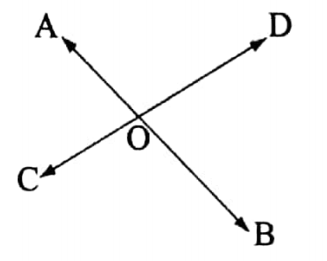
Solution:
\(\overleftrightarrow{A B}\) is a straight line and 0 is a point on it.
From O, two straight lines \(\overrightarrow{O C}\) and \(\overrightarrow{O D}\)are drawn on the opposite sides of \(\overleftrightarrow{A B}\),
such that ∠AOC = ∠BOD.
It is required to prove that :
\(\overrightarrow{O C}\) and \(\overrightarrow{O D}\) will lie on the same straight line.
Proof: It is given that∠AOC = ∠BOD …. (1)
Since, \(\overrightarrow{O C}\)stands on \(\overleftrightarrow{A B}\) therefore, ∠AOC + ∠BOC = 180°
or, ∠BOD + ∠BOC = 180° [From (1)]
Hence, \(\overrightarrow{O C}\) and \(\overrightarrow{O D}\)will lie on the same straight line.
Example 5
Prove that, the bisectors of a pair of vertically opposite angles lie on the same straight line.
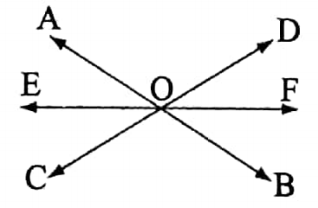
Let \(\overleftrightarrow{A B}\) and \(\overleftrightarrow{C D}\) be the two straight lines that intersect at O.
Here ∠AOC and ∠DOB are pairs of vertically opposite angles.
Let, \(\overrightarrow{O E}\) be the bisector of ∠AOC and \(\overrightarrow{O F}\) be the bisector of ∠DOB.
It is required to prove that: \(\overrightarrow{O E}\) and \(\overrightarrow{O F}\) lie on the same straight line.
Proof: Since \(\overrightarrow{O E}\)is the bisector of∠AOC,
∴ ∠AOE = ∠COE
Also, \(\overrightarrow{O F}\) is the bisector of∠DOB, ∠DOF =∠BOF
Again, ∠AOD = vertically opposite ∠BOC
Hence, ∠AOE +∠AOD +∠DOF = ∠COE +∠BOC +∠BOF
= 1/2 (∠AOE + ∠AOD + ∠DOF + ∠COE + ∠BOC +∠BOF)
= 1/2 x 4 right angles = 2 right angles
∴ ∠EOF = a straight angle
\(\overrightarrow{O E}\) and \(\overrightarrow{O F}\) lie on the same straight line
Example 6
\(\overleftrightarrow{P Q}\) and \(\overrightarrow{R S}\) are two straight lines intersecting at O. Bisector of ∠POR is \(\overrightarrow{O X}\). \(\overrightarrow{O X}\) is produced through O. Prove that it will bisect ∠SOQ,
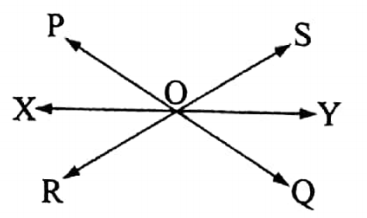
Solution:
\(\overleftrightarrow{P Q}\) and \(\overleftrightarrow{R S}\) are two straight lines intersecting at O.
\(\overrightarrow{O X}\) is the bisector of
∠POR. \(\overleftarrow{X O}\) is produced to Y.
It is required to prove that: \(\overrightarrow{Q Y}\) bisects ∠SOQ.
Proof: ∠POX=vertically opposite ∠QOY and ∠BOX = vertically opposite ∠SOY.
Since, \(\overrightarrow{O X}\)is the bisector of∠POR therefore, ∠POX = ∠ROX Hence, ∠QOY = ∠SOY
:. \(\overrightarrow{O Y}\) bisects ∠SOQ.
Step-by-Step Guide to Geometric Theorems
Theorem 4
When a straight line cuts two other straight lines, those other two straight lines are parallel if either
1. A pair of alternate angles are equal, or,
2. A pair of interior angles on the same side of the transversal are together equal to two right angles.
Let the straight lines \(\overleftrightarrow{E F}\) intersect the straight lines \(\overleftrightarrow{A B}\) and \(\overleftrightarrow{C D}\) at G and H respectively.
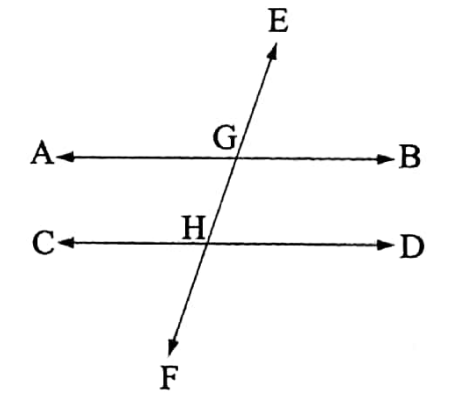
1. Let, ∠AGH = alternate ∠GHD.
It is required to prove that: \(\overleftrightarrow{A B}\) and \(\overleftrightarrow{C D}\) are parallel to each other.
Proof: Since the straight lines \(\overleftrightarrow{A B}\) and
\(\overleftrightarrow{E F}\) intersect each other at G,
∴ ∠AGH = vertically opposite ∠EGB.
But ∠AGH =∠GHD (given)
∴∠EGB = ∠GHD
But they are corresponding angles.
∴ \(\overleftrightarrow{A B}\) and \(\overleftrightarrow{C D}\) are parallel to each other.
2. Let,∠BGH + ∠GHD = 2 right angles
It is required to prove that: \(\overleftrightarrow{A B}\) and \(\overleftrightarrow{C D}\) are parallel to each other.
Proof: Since the straight line \(\overleftrightarrow{G B}\) stands on the straight line \(\overleftrightarrow{E F}\)
∠EGB + ∠BGH – 2 right angles.
But, ∠BGH +∠GHD = 2 right angles (given)
∠EGB +∠BGH = ∠BGH +∠GHD
or, ∠EGB = ∠GHD.
But they are corresponding angles
\(\overleftrightarrow{A B}\) and \(\overleftrightarrow{C D}\) are parallel to each other.
Verification of Theorem-4 :
1. Draw any angle ∠AGH.
Then draw another angle ∠GHD (equal in measure to∠AGH) where D is on the opposite side of \(\overline{G H}\)on which point A lies.
Extend \(\overline{A G}\) up to B and \(\overline{D H}\) in the opposite direction up to C.
Also, extend \(\overline{H G}\) up to E in one direction and up to F in another direction.
You will find that \(\overleftrightarrow{A B}\) || \(\overleftrightarrow{C D}\).
2. Draw any angle ∠BGH. Then draw another angle ∠GHD supplementary of∠BGH, where B and D are the points on the same side of \(\overline{G H}\).
Extend \(\overline{D G}\) up to A and \(\overline{D H}\) up to C in the same direction.
Also, extend \(\overline{H G}\) up to E in one direction and up to F in another direction.
You will find that \(\overleftrightarrow{A B}\) | | \(\overleftrightarrow{C D}\).
Theorem 5
If a straight line cuts two parallel straight lines, then
1. The corresponding angles are equal.
2. The alternate angles are equal.
3. The interior angles on the same side of the transversal are together equal to two right angles.
Let the straight line \(\overleftrightarrow{E F}\) cut two parallel straight lines \(\overleftrightarrow{A B}\) and \(\overleftrightarrow{C D}\) at points G and H respectively.
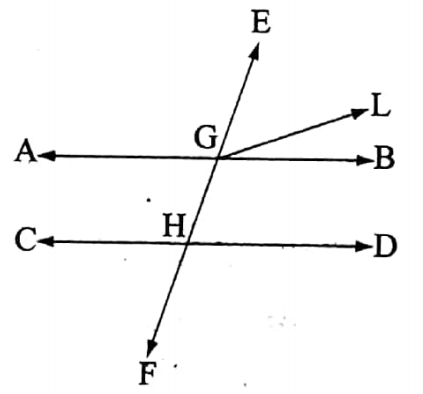
It is required to prove that :
1. ∠EGB= corresponding ∠GHD
2. ∠AGH= alternate ∠GHD
3. ∠BGH+ ∠GHD = 2 right angles.
Proof :
1. Let ∠EGB = not
Then let∠EGL drawn at the point G be equal to ∠GHD.
Then, the straight line \(\overleftrightarrow{E F}\)intersects two straight lines GL and \(\overleftrightarrow{C D}\) at G and H respectively and
∠EGL = corresponding ∠GHD [By assumption]
Hence, \(\overrightarrow{G L}\) || \(\overleftrightarrow{C D}\)
Thus two intersecting straight lines \(\overrightarrow{G L}\) and \(\overleftrightarrow{A B}\)are both parallel to the straight line \(\overleftrightarrow{C D}\).
But according to Playfair’s Axiom, this is impossible. Hence, ∠EGB and ∠GHD cannot be of unequal measure.
∴∠EGB = ∠GHD
1.∠EGB = ∠GHD(Proved) and ∠EGB = vertically opposite∠AGH
Hence, ∠AGH = ∠GHD
2. ∠EGB= ∠GHD (Proved)
Also since the straight line GB stands on the straight line \(\overleftrightarrow{E F}\) therefore,
∠BGH + ∠EGB = 2 right angles
Hence, ∠BGH + ∠GHD = 2 right angles.
Verification of Theorem-5 :
Draw any two parallel straight lines
\(\overleftrightarrow{A B}\)and \(\overleftrightarrow{C D}\).
Draw a transversal \(\overleftrightarrow{E F}\)which intersects \(\overleftrightarrow{A B}\) at G and \(\overleftrightarrow{C D}\) at H.
Measuring with a protractor you will find that,
1. ∠EGB= ∠GHD
2.∠AGH = ∠GHD
3. ∠BGH + ∠GHD= 180°.
Some Examples
Example 1
\(\overleftrightarrow{A B}\) and \(\overleftrightarrow{C D}\) are two parallel straight lines. E and F are two points on \(\overleftrightarrow{A B}\) and \(\overleftrightarrow{C D}\) respectively. P is a point in the region between \(\overleftrightarrow{A B}\) and \(\overleftrightarrow{C D}\) such that ∠BEP = 40° and ∠PFD = 60°. Find the measure of∠EPF.
Solution:
Draw a straight line \(\overleftrightarrow{G H}\) parallel to \(\overleftrightarrow{A B}\) or \(\overleftrightarrow{C D}\) through the point P.
Now, \(\overleftrightarrow{A B}\) and \(\overleftrightarrow{G H}\) are parallel, and \(\overline{E P}\) is the transversal
.’. ∠GPE = alternate ∠BEP = 40°.
Again,\(\overleftrightarrow{G H}\) and \(\overleftrightarrow{C D}\) are parallel, and \(\overline{P F}\) is the transversal
∴ ∠GPF = alternate ∠PFD = 60°
∠EPF = ∠GPE + ∠GPF
= 40° + 60°
= 100°.
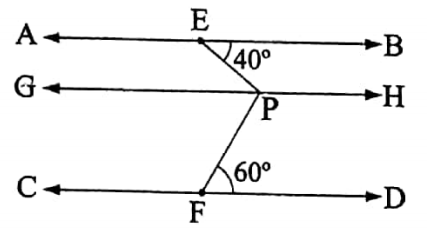
Example 2
\(\overleftrightarrow{A B}\) and \(\overleftrightarrow{C D}\) are two parallel straight lines. P is a point such that ∠BAP = 105° and ∠DCP = 110°. Find the measure of ∠APC.
Solution:
Draw a straight line \(\overrightarrow{P Q}\) parallel to \(\overleftrightarrow{A B}\) or \(\overleftrightarrow{C D}\)
Now, since \(\overleftrightarrow{A B}\) || \(\overleftrightarrow{P Q}\) and \(\overleftarrow{A P}\) are the transversal
∠BAP + ∠APQ = 180°
or, ∠APQ = 180° – ∠BAP
= 1∠0° – 105° = 75°
Also, since \(\overrightarrow{P Q}\) | | \(\overleftrightarrow{C D}\) and \(\overrightarrow{C P}\) is the transversal
∴ ∠QPC + ∠PCD = 180°
or, ∠QPC = 180° – ∠PCD
= 180° – 110° = 70°
∴∠APC = ∠APQ + ∠QPC
= 75° + 70°
= 145°.
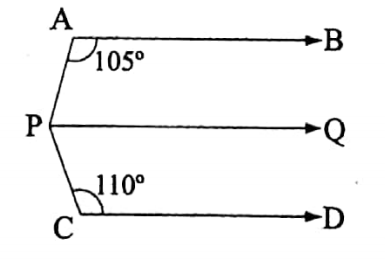
Example 3
In the figure shown below \(\overleftrightarrow{B C}\) || \(\overleftrightarrow{D E}\). ∠ABC = 50°, ∠CBD = 95° and ∠EDG = 50°. Find the measures of the angles of ABFD.
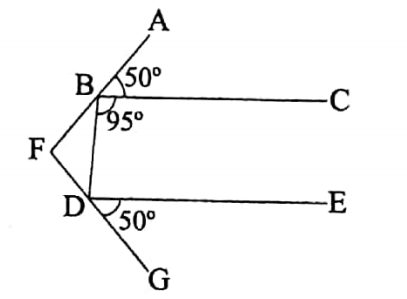
Solution:
Since ∠ABF is a straight angle, therefore, ∠ABC + ∠CBD + ∠DBF = 180°
or, 50° + 95° + ∠DBF = 180°
or, ∠DBF = 180° – 145°
= 35°
Now, \(\overleftrightarrow{B C}\) | | \(\overleftrightarrow{D E}\) and \(\overleftrightarrow{B D}\) is the transversal
∴ ∠CBD + ∠BDE – 180°
or, ∠BDE = 180° – ∠CBD
= 180° – 95°
= 85°
Also, ∠FDG is a straight angle therefore, ∠FDB + ∠BDE + ∠EDG = 180°
or, FDB = 85° + 50° = 180°
or,∠FDB = 180° – 135°
= 45°
Hence, in the ΔBFD,
∠BFD = 180° – (∠DBF + ∠FDB)
= 180° – (35° + 45°)
= 180° – 80°
= 100°
Example 4
If the sides of one angle are respectively parallel to the sides of another angle, then the angles are either equal or supplementary.
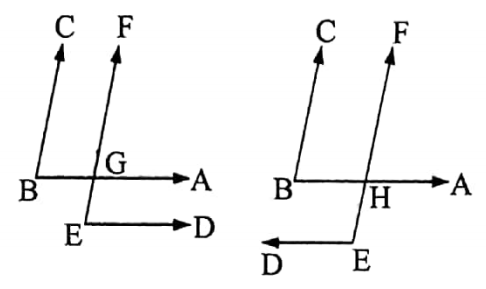
Solution:
Let the sides \(\overleftrightarrow{A B}\) and \(\overleftrightarrow{B C}\) of the ∠ABC
be respectively parallel to the sides \(\overleftrightarrow{D E}\) and \(\overleftrightarrow{E F}\) of the ∠DEF.
Let the point of intersection of \(\overleftrightarrow{A B}\) and \(\overleftrightarrow{E F}\) in the first be G and that in the second figure be H.
We have to prove that: Either ∠ABC = ∠DEF or ∠ABC and ∠DEF are supplementary.
Proof: In the first figure, since \(\overleftrightarrow{B C}\)| | \(\overleftrightarrow{F G}\)
and \(\overleftrightarrow{B A}\) is the transversal,
.’. ∠AGF = ∠ABC (corresponding angle)
Also, \(\overleftrightarrow{B A}\) || \(\overleftrightarrow{E D}\) and EF are the transversal,
∠AGF = ∠GED (corresponding angle)
∴ ∠ABC =∠GED
i.e., ∠ABC = ∠DEF.
In the second figure, since \(\overleftrightarrow{B C}\) || \(\overleftrightarrow{F H}\) and \(\overleftrightarrow{B A}\) is the transversal,
∴ ∠CBH + ∠BHF = 180°
Also, \(\overleftrightarrow{B A}\) || \(\overleftrightarrow{D E}\) and \(\overleftrightarrow{E F}\) is the transversal
.’. ∠BHF = ∠DEH (corresponding angle)
∴ ∠CBH + ∠DEH = 180°
i.e., ∠ABC +∠DEF = 180°
Hence, ∠ABC and ∠DEF are supplementary.
Example 5
The straight lines which are parallel to the same straight line are parallel to one another
solution :
Let the straight lines \(\overleftrightarrow{A B}\) and \(\overleftrightarrow{C D}\) be parallel to \(\overleftrightarrow{E F}\).
It is required to prove that: \(\overleftrightarrow{A B}\) || \(\overleftrightarrow{C D}\)
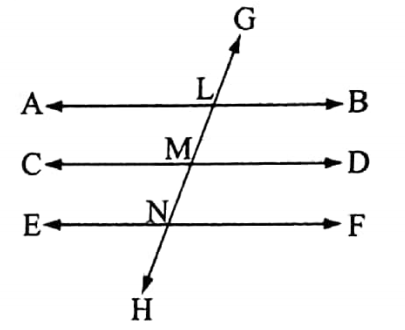
Construction: A straight line \(\overleftrightarrow{G H}\) drawn which intersects \(\overleftrightarrow{A B}\), \(\overleftrightarrow{C D}\), and at the points L, M, and N respectively.
Proof: Since \(\overleftrightarrow{A B}\) || \(\overleftrightarrow{E F}\) and \(\overleftrightarrow{G H}\) is the transversal
∴ ∠GLB= corresponding ∠LNF
Again, since \(\overleftrightarrow{C D}\) || \(\overleftrightarrow{E F}\) and \(\overleftrightarrow{G H}\) is the transversal
∴ ∠LMD = corresponding ∠LNF
Hence, ∠GLB = ∠LMD
But they are corresponding angles
∴ \(\overleftrightarrow{A B}\) || \(\overleftrightarrow{C D}\)
Example 6
The straight lines which are perpendicular to the same straight line are parallel to one another.
Solution :
Let the straight fines \(\overleftrightarrow{A B}\) and \(\overleftrightarrow{C D}\) be both perpendicular to the straight fine \(\overleftrightarrow{E F}\).
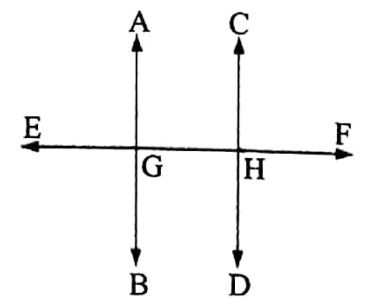
Solution:
Let the point of intersection of \(\overleftrightarrow{A B}\) and
\(\overleftrightarrow{E B}\) be G and that of \(\overleftrightarrow{C D}\) and \(\overleftrightarrow{E F}\) be H.
It is required to prove that: \(\overleftrightarrow{A B}\) || \(\overleftrightarrow{C D}\).
Proof: Since \(\overleftrightarrow{C D}\) ⊥ \(\overleftrightarrow{E F}\)
∠CHF = 90° and since \(\overleftrightarrow{A B}\) ⊥ \(\overleftrightarrow{E F}\) ∠AGF = 90°
∠CHF = ∠AGF
But they are corresponding angles. Hence, \(\overleftrightarrow{A B}\) || \(\overleftrightarrow{C D}\).
Theorem 6
If one side of a triangle is produced, the exterior angle so formed is equal to the sum of two interior opposite angles.
Let ABC be a triangle. The side BC of the triangle is produced to point D. So, ∠ACD is an exterior angle and with respect to it ∠ABC and ∠BAC are two interior opposite angles.
It is required to prove that :
∠ACD = ∠ABC + ∠BAC.
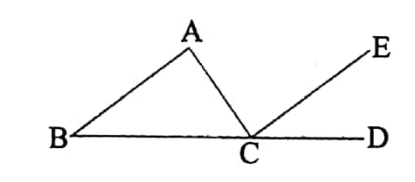
Construction: Through C draw a straight line\(\overline{C E}\) parallel to \(\overline{B A}\)
Proof: Since \(\overline{A B}\) || \(\overline{E C}\) and \(\overline{B D}\) is the transversal
.’. ∠ECD = corresponding∠ABC
Again, \(\overline{A B}\) || \(\overline{E C}\) and \(\overline{A C}\) is the transversal
∠ACE = alternate ∠BAC
Hence, ∠ECD + ∠ACE = ∠ABC + ∠BAC
or, ∠ACD = ∠ABC + ∠BAC.
Verification of Theorem-6 :
Draw any triangle ABC. Extend the side \(\overline{B C}\) up to D.
Measure with a protractor the angles ∠ACD, ∠ABC, and ∠BAC.
You will find that ∠ACD = ∠ABC +∠BAC
Theorem 7
The sum of the three angles of a triangle is equal to two right angles.
Let ABC be a triangle.
It is required to prove that: ∠ABC + ∠BCA + ∠CAB = 2 right angles.
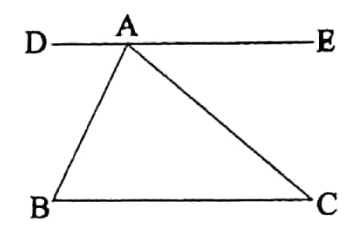
Construction: Through point A, \(\overline{D E}\) is drawn parallel to \(\overline{B C}\).
Proof: Since \(\overline{D E}\) || \(\overline{B C}\) and \(\overline{A C}\) is the transversal
∠EAC = alternate ∠BCA.
Also, since \(\overline{D E}\) || \(\overline{B C}\) and \(\overline{A B}\) is the transversal
∠DAB = alternate ∠ABC
Hence, ∠EAC + ∠DAB = ∠BCA + ∠ABC Adding ∠BAC on both sides we get,
∠EAC + ∠DAB +∠BAC =∠BCA + ∠ABC + ∠BAC
or, ∠ABC + ∠BCA + ∠CAB = ∠EAC +∠BAC + ∠DAB = 2 right angles.
Verification of Theorem-7 :
Draw any triangle ABC.
Measure its three angles with a protractor.
You will find that ∠ABC + ∠BCA + ∠CAB = 2 right angles.
Some Examples
Example 1
If the measures of the two angles of a triangle be 65° and 48° then find the measure of the third angle.
Solution :
We know that the sum of the three angles of a triangle is equal to 180°.
Hence, if any two angles be 65° and 48° then the third angle
= 180° – (65° + 48°)
= 180° – 113°
= 67°
Example 2
Between the two trianglesΔABC and A DEF if ∠ABC = ∠DEF and ∠ACB = ∠DFE then prove that ∠BAC = ∠EDF.
Solution :
Given:
ΔABC and ADEF are two triangles such that ∠ABC = ∠DEF and ∠ACB = ∠DFE.
It is required to prove that ∠BAC = ∠BDF.
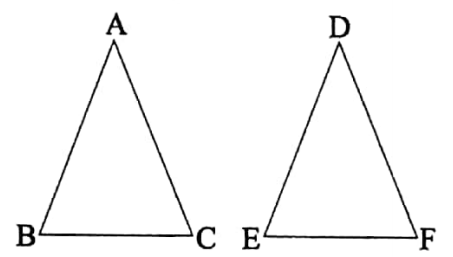
Proof: In the ΔABC,
∠ABC + ∠ACB + ∠BAC = 180° …. (1)
In the ΔDEF
∠DEF + ∠DFE + ∠EDF = 180° …. (2)
From (1) and (2) we get,
∠ABC + ∠ACB + ∠BAC = ∠DEF + ∠DFE + ∠EDF …… (3)
Also, it is given that,
∠ABC = ∠DEF and ∠ACB = ∠DFE
.-. ∠ABC + ∠ACB =∠DEF + ∠DFE …. (4)
By (3) – (4) we get,
∠BAC = ∠EDF.
Example 3
Prove that the two acute angles of a right-angled triangle are complementary to one another.
Solution :
Let ABC be a right-angled triangle, in which ∠ABC is a right angle.
Hence, ∠BAC and ∠BCA are the two acute angles.
It is required to prove that∠BAC and ∠BCA are complementary to one another.
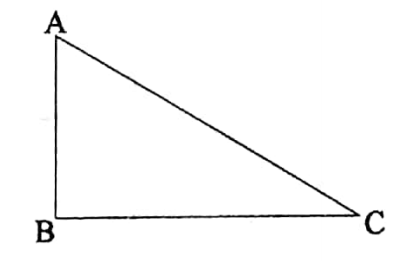
Proof: Since ABC is a triangle, therefore, ∠ABC + ∠BCA + ∠BAC = 180°
or, ∠BCA + ∠BAC = 180° – 90° [ ∠ABC = 90°]
or, ∠BAC +∠BCA = 90°
Hence, ∠BAC and ∠BCA are complementary to one another.
Example 4
If the sides of a triangle are produced in the same order then prove that the sum of the exterior angles is equal to 360°.
Solution :
Let ABC be a triangle.
Let the sides BC, CA, and AB be produced to the points D, E, and F respectively.
Thus, three exterior angles ∠ACD, ∠BAE, and ∠CBF are produced.
It is required to prove that: ∠ACD + ∠BAE + ∠CBF = 360°.
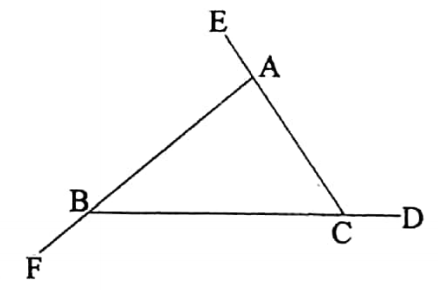
Proof: We know that, if one side of a triangle is produced, the exterior angle so formed is equal to the sum of two interior opposite angles.
∠ACD = ∠ABC + ∠BAC …….. (1)
∠BAE = ∠ABC + ∠ACB ……… (2)
∠CBF =∠ACB + ∠BAC ……… (3)
Adding (1), (2) and (3) we get, ∠ACD + ∠BAE + ∠CBF
= 2 (∠ABC + ∠ACB + ∠BAC)
= 2 x 180° [ sum of three angles of a triangle = 180]
= 360°.
Example 5
The side \(\overline{B C}\)– of the triangle, ABC is produced to D. If ∠ACD = 112° and ∠B =3/4 ∠A then what is the value of ∠B?
Solution:
Given:
The side \(\overline{B C}\)– of the triangle, ABC is produced to D.
Let ∠A = x° then ∠B = 3xº / 4
Now, ∠A + ∠B = 112º
or, xº + 3xº / 4 = 11
or, 7xº / 4 = 112º
or, xº = 112º x 4/7
∴ ∠B = 3/4 x 64º
= 48º
∠B = 48º
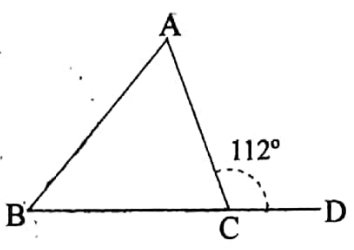
Example 6
PQR is a triangle. \(\overline{P S}\) is drawn perpendicular .from P on \(\overline{Q R}\). \(\overline{P T}\) is the bisector, of the angle ∠QPR. Prove that ∠TPS = 1/2(∠PRQ – ∠PQR).
Solution :
Given:
PQR is a triangle. \(\overline{P S}\)T \(\overline{Q R}\) and \(\overline{P T}\) is the bisector of ∠QPR.
Proof: Since ∠PST is the exterior angle of APSR
∠PRS + ∠SPR = ∠PST = 90° …. (1)
Also since ∠PSR is the exterior angle of APQS
:. ∠PQS + ∠QPS = ∠PSR = 90° …. (2)
From (1) a∠d (2)
∠PRS + ∠SPR = ∠PQS + ∠QPS
or, ∠PRS – ∠PQS
= ∠QPS – ∠SPR
= ∠QPT + ∠TPS – ∠SPR .
= ∠TPR + ∠TPS – ∠SPR
[ ∠QPT= ∠TPR]
(∠TPR – ∠SPR)+ ∠TPS
∠TPS + ∠TPS= 2. ∠TPS
Hence, ∠TPS = 1/2(∠PRS – ∠PQS)
i.e., ∠TPS = 1/2(∠PRQ – ∠PQR).
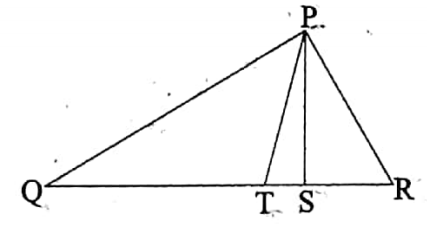
Proof: Since ∠PST is the exterior of APSR
∠PRS + ∠SPR = ∠PST = 90° …. (1)
Also since ∠PSR is the exterior angle of APQS
:. ∠PQS + ∠QPS = ∠PSR = 90° …. (2)
From (1) and (2)
∠PRS + ∠SPR = ∠PQS + ∠QPS
or, ∠PRS – ∠PQS = ∠QPS – ∠SPR = ∠QPT + ∠TPS – ∠SPR .
= ∠TPR +∠TPS – ∠SPR
[ ∠QPT= ∠TPR]
1. (∠TPR – ∠SPR)+ ∠TPS
2. ∠TPS + ∠TPS= 2. ∠TPS
Hence, ∠TPS = 1/2(∠PRS – ∠PQS)
i.e., ∠TPS = 1/2(∠PRQ – ∠PQR).
Practice Problems on Geometry Theorems
Example 7
ABC is a triangle. BO and CO are the bisectors of the angles∠ABC and ∠ACB. Prove that ∠BOC – 90° + ∠BAC.
Solution:
Given:
ABC is a triangle.
BO and CO are the bisectors of the angles ∠ABC and∠ACB.
It is required to prove that : ∠BOC = 90° + 1/2 ∠BAC.
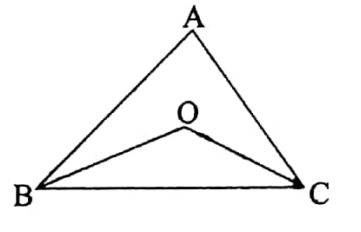
Proof: Since BO is the bisector of ∠ABC
∠OBC = 1/2 ∠ABC…….. (1)
Also since CO is the – bisector of ∠ACB
∴ ∠OCB =∠ACB ……..(2)
Adding (1) and (2) we get,
∠OBC + ∠OCB = (∠ABC + ∠ACB) ……… (3) Now,
∠BOC = 180° – (∠OBC + ∠OCB)
= 180° – 1/2 ∠ABC + ∠ACB) [From (3)]
= 180° – 1/2 (180° – ∠BAC]
= 180° – 90° + 1/2 ∠BAC
= 90° + 1/2 ∠BAC
Example 8
ABC is a triangle. \(\overline{B O}\) and \(\overline{C O}\) are the external bisectors of the angles ∠ABC and ∠ACB. Prove that ∠BOC = 90° + 1/2 ∠BAC.
Solution :
Given:
ABC is a triangle. \(\overline{B O}\). and \(\overline{C O}\) is the external bisectors of the angles ∠ABC and ∠ACB, which means that if the sides \(\overline{A B}\) and \(\overline{A C}\) of the triangle ABC are produced to D and E respectively then \(\overline{B O}\) and \(\overline{C O}\) are the bisectors of ∠CBD and ∠BCE.
It is required to prove that: ∠BOC = 90° – 1/2 ∠BAC.
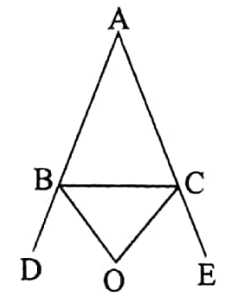
Proof: In the ΔABC, ∠CBD is an exterior angle.
∴ ∠CBD = ∠ACB + ΔBAC ……… (1)
Also, ∠BCE is an exterior angle
∴ ∠BCE = ∠ABC +ΔBAC ……… (2)
Adding (1) and (2) we get,
∠CBD + ∠BCE = ∠ACB +ΔBAC + ∠ABC + ΔBAC = 180° + ΔBAC
1/2 (∠CBD + ∠BCE) = 90° + 1/2 ABAC
or, ∠OBC + ∠OCB = 90° + 1/2 ∠BAC …….. (3)
∴ ∠BOC = 180° – (∠OBC + ∠OCB)
= 180° – (90° + 1/2 ∠BAC) [From (3)]
= 90°’- 1/2 ∠BAC.
Example 9
AB is the hypotenuse of the isosceles right-angled triangle ABC. AD is the bisector of ABAC and AD intersects BC at D. Prove that, AC + CD = AB.
Solution:
Given:
AB is the hypotenuse of the isosceles right-angled triangle ABC.
AD is the bisector of ABAC and AD intersects BC at D.
It is required to prove that, AC + CD = AB.
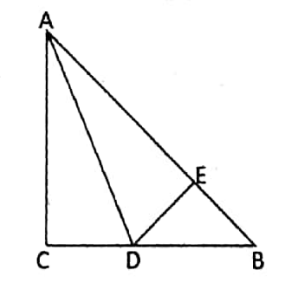
Construction: DE is drawn perpendicular to AB from D.
Proof: Since ΔABC is a right-angled isosceles triangle, therefore, ΔBAC = ∠ABC = 45°. i.e., ΔEBD = 45°.
Again, DE ⊥ AB ΔDEB = 90°
∴ ΔBDE = 45°.
In ΔACD and ΔADE,
∠CAD = ∠EAD (according to construction),
∠ACD = ∠AED = 90°, and AD is the common side.
∴ ΔACD ≅ ΔADE
CD = DE and AC = AE
Again since,ΔEBD – ΔBDE
DE = BE
Now, AC + CD = AE + DE = AE + BE = AB (Proved).
Example 10
In ΔABC, the external bisector of ∠ACB meets the line through point A and parallel to the side BC at point D. Prove that, ΔADC = 90° – 1/2 ∠ACB
Solution:
Given:
In.ΔABC, the external bisector of ∠ACB meets the line through point A and parallel to the side BC at point D.
It is required to prove: ΔADC = 90° – 1/2 ∠ACB.
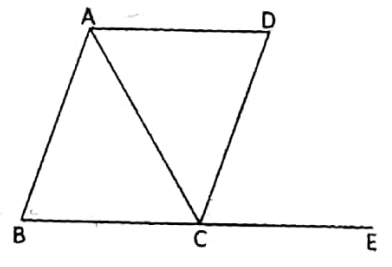
Construction: BC is extended upto the point E.
Proof: ΔADC = 180° – ΔDAC – ΔACD
= 180° – ∠ACB – 1/2∠ACE [ AD || BC, AC is the traversal ∠DAC = ∠ACB ]
= 180 ° – 1/2 ∠ACB – 1/2 ∠ACB – 1/2 ∠ABC – 1/2 ∠BAC
=180° – 1/2 (∠ABC + ∠ACB +∠BAC) – 1/∠ ACB
= 180° – 90° – 1/2 ∠ACB
= 90° – 1/2 ∠ACB (proved)
Polygon
A plane figure enclosed by a number of line segments is called a polygon.
A polygon is named according to the variation in the number of sides. Triangle is a polygon of three sides and a quadrilateral is a polygon of four sides.
Some examples of a polygon are:
Pentagon —A polygon having five sides.
Hexagon— A polygon having six sides.
Heptagon—A polygon having seven sides.
Octagon—A polygon having eight sides.
Nonagon—A polygon having nine sides.
Decagon—A polygon having ten sides.
Convex polygon
A polygon without any reflex angle is called a convex polygon. In other words, it can be said that each interior angle of a convex polygon is less than two right angles. In general, by the term polygon, we mean convex polygon.
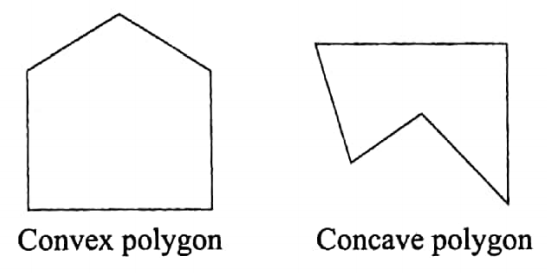
Regular polygon
If all the sides of a polygon are equal in length and the measures of all the angles are equal then the polygon is called a regular polygon. In most of cases, it is found that if the lengths of the sides of a polygon are equal then its angles are also of equal measure. For example, in an equilateral triangle, each of the three angles is 60°.
In a square, each angle is equal to 90°. In a regular pentagon, each angle is equal to 108°. In a regular hexagon, each angle is equal to 120°. But there is an exception also. All four sides of a rhombus are equal in length but its four angles are not equal to each other. So rhombus cannot be said a regular polygon.
Diagonals of a polygon
The line segments obtained by joining with a vertex of any polygon all vertices other than those which he just on both sides of it, are called the diagonals of that polygon.
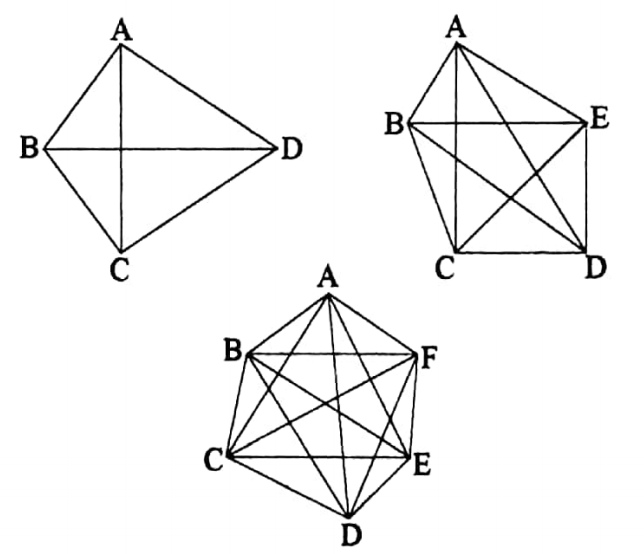
The number of diagonals of a polygon of n sides is equal to \(\frac{n(n-1)}{2}-n\)
Number of sides of a quadrilateral = 4
∴ The number of its diagonals
= \(\frac{4(4-1)}{2}-4\)
= 6-2
= 2
Number of sides of a pentagon = 5
∴ The number of its diagonals
= \(\frac{5(5-1)}{2}-5\)
= 10 – 5
= 5
Number of sides of a hexagon = 6
∴ The number of its diagonals
= \(\frac{6(6-1)}{2}-6\)
= 15-6
= 9
The Two diagonals of the quadrilateral ABCD are AC and BD.
The five diagonals of the pentagon ABCDE are AC, AD, BE, BD, and CE.
Nine diagonals of the hexagon ABCDEF are AC, AD, AE, BF, BE, BD, CF, CE, and DF.
Some information about the interior and the exterior angles of polygons
In any polygon, the number of angles is equal to the number of sides. For example, a polygon with 10 sides will have 10 angles.
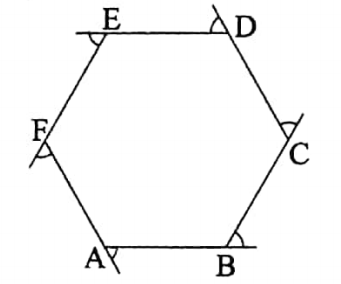
By the angle of a polygon, we mean its interior angle. For example, the interior angles of the polygon ABCDEF are ∠ABC, ∠BCD, ∠CDE, ∠DEF, ∠EFA, and ∠FAB. The adjacent supplementary angle of any interior angle is called the exterior angle of the polygon. The angles indicated in the figure are the exterior angles of the polygon ABCDEF.
The interior angles and the exterior angles obey the following relations :
1. The sum of the interior angles of a polygon of n sides is (2n-4) right angles or (2n-4) x 90°.
2. The measure of each angle of a regular polygon is the \(\frac{(2n – 4)}{n}\) right angle or, \(\frac{(2n – 4)}{n} . 90º\)
3. In any polygon the sum of one interior and one exterior angle is 180° or 2 right angles.
4. If the sides of a polygon are extended in the same order the sum of the exterior angles produced is equal to four right angles.
5. The measure of each exterior angle of a regular polygon of n sides is 4/n right angles.
Theorem 8
The sum of the interior angles of a polygon of n sides is equal to 2(n -2) right angles.
Let ABCDEF…. be a polygon of n sides. It is required to prove that, the sum of the interior angles of this polygon = 2 (n – 2) right angles.
Construction: Take any point O inside the polygon. Join the angular points A, B, C, D, E, F…. of the polygon with O.
Thus, n triangles are formed.
Proof: Since the sum of the angles of each triangle = 2 right angles therefore the sum of the angles of n triangles =
2n right angles.
Now, the sum of the angles of these n triangles = sum of the interior angles of the polygon + the sum of the angles at point O.
But the sum of the angles at the point O = 4 right angles.
∴ The sum of the interior angles of the polygon + 4 right angles = 2n right angles.
.’. sum of the interior angles of the polygon = (2n – 4) right angles = 2 (n – 2) right angles.
Verification of Theorem-8 :
Since the sum of the interior angles of a polygon depends upon its number of sides, Theorem-8 cannot be verified directly.
However, it may be verified part by part.
Some of the interior angles of a quadrilateral
= 2 (4 – 2) right angles
= 4 right angles
Some of the interior angles of a pentagon
= 2 (5 – 2) right angles
= 6 right angles
Some of the interior angles of a hexagon
= 2 (6 – 2) right angles
= 8 right angles
Thus, if you draw any quadrilateral and measure its interior angles with a protractor then you will find that the sum of the interior angles
= 4 right angles
= 360°.
Similarly, drawing any pentagon you will find that the sum of the interior angles
= 6 right angles
= 540°.
Also, drawing any hexagon you will find that the sum of the interior angles
= 8 right angles
= 720°.
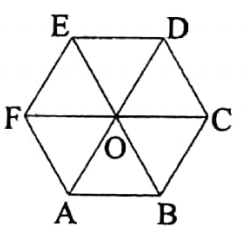
Some Examples
Example 1
If the sides of a polygon are extended in the same order the sum of the exterior angles produced is equal to four right angles.
Solution :
Let, ABCDEF…. be a polygon of side n, whose sides are extended in the same order.
It is required to prove that, the sum of the exterior angles = 4 right angles.
Proof: Since, at each angular point, the sum of an interior angle and exterior angle
= 2 right angles, therefore, the sum of n interior angles + sum of n exterior angles
= 2n right angles.
or, (2n – 4) right angles + sum of n exterior angles
= 2n right angles
or, the sum of n exterior angles
= (2n – 2n + 4) right angles
= 4 right angles.
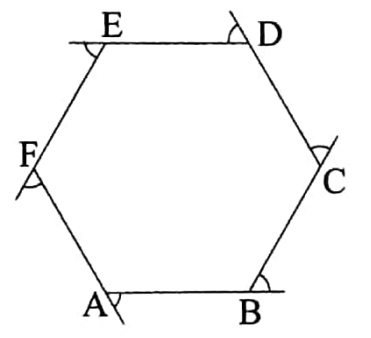
Examples of Common Geometry Theorems
Example 2
Find the number of sides of the polygon whose sum of the interior angles is 1440°.
Solution :
Let, the number of sides of the polygon is n.
Therefore, (2n – 4) x 90 = 1440
or, 2n – 4 = 1440/90
= 16
or, 2n = 16 + 4
or, 2n = 20
or, n = 20/2
= 10
∴ The number of sides of the polygon is 10.
Example 3
Can 110° be an angle of a regular polygon?
Solution :
Let, if possible each angle of a regular polygon of n sides be 110°.
Therefore, \(\frac{(2n – 4)}{n}\) x 90 = 110
or, 9 (2n – 4) = 11 n
or, 18n – 36 = 11 n
or, 18n – 11 n = 36
or, 7n = 36
or, n = 36/7
= 5 1/7
But, since the number of sides of a polygon cannot be a fraction so 110° cannot be an angle of a regular polygon.
Example 4
Each interior angle of a regular polygon is 144°. Find the number of sides of the polygon.
Solution :
Given:
Each interior angle of the regular polygon = 144°
∴ Each exterior angle
= 180° – 144°
= 36° Number of exterior angles = 360/36
= 10
∴ Number of sides = 10
Example 5
The four angles of a pentagon are 40°, 80°, 120° and 160°. What is the measure of the fifth angle?
Solution :
Given:
The four angles of a pentagon are 40°, 80°, 120° and 160°.
The sum of the angles of a pentagon
= (2 x 5-4) right angles
= 6 right angles
= 6 x 90°
= 540°
Now, the sum of the four angles
= (40° + 80° + 120° + 160°)
= 400°
∴ The measure of the fifth angle
= (540° – 400°)
= 140°
Example 6
Each interior angle of a regular polygon is three times its exterior angle. Find the number of sides of the regular polygon.
Solution:
Given:
Each interior angle of a regular polygon is three times its exterior angle.
Let, each exterior angle = x°
∴ Each interior angle = 3x°
∴ x° + 3x° = 180°
or, 4x° = 180°
or, x° = 180° / 4
= 45°
∴ Each exterior angle = 45°
∴ Number of exterior angles = 360 / 45
= 8
∴ Number of sides = 8
Example 7
Each of the five angles of a polygon is equal to 172° and the other angles are 160° each. Find the number of sides of the polygon.
Solution:
Given:
Each of the five angles of a polygon is equal to 172° and the other angles are 160° each.
Since each of the five angles is equal to 172°,
therefore, the corresponding exterior angles are each equal to (180° – 172°) = 8°
∴ sum of those five exterior angles = 5 x 8° = 40°
∴ The sum of the other exterior angles
= 360° – 40°
= 320°
Now, some of the angles of the polygon are each equal to 160°.
Hence, the corresponding exterior angles are each equal to 180° – 160° = 20°
∴ Number of such exterior angles = 320/20
= 16
∴ Total number of sides of the polygon
= (5 + 16)
= 21
Example 8
Find the number of diagonals of a polygon of 12 sides.
Solution:
The number of diagonals of a polygon of 12 sides
= \(\frac{12(12-1)}{2}-12\)
= \(\frac{(12 . 11)}{2}-12\)
= 66 – 12
= 54.
Conceptual Questions on Applications of Theorems
Theorem 9
If two sides of a triangle are equal, the angles opposite to them are also equal.
Let ABC be a triangle in which AC = AB.
It is required to prove that, ∠ABC = ∠ACB
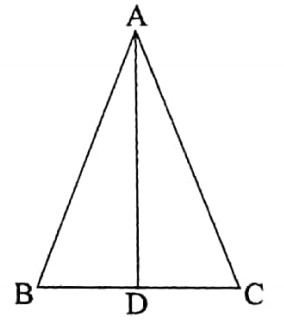
Construction: The bisector \(\overline{A D}\) of ∠BAC is drawn which intersects \(\overline{B C}\) at point D.
Proof: In the triangles ΔARD and ΔACD,
\(\overline{A B}\) = \(\overline{A C}\), \(\overline{A D}\) is common and included ∠BAD = included ∠CAD
ΔABD ≅ ΔACD
Hence,∠ABD =∠ACD
i.e., ∠ABC = ∠ACB
Verification of Theorem – 9 :
Construct a triangle ΔABC in which \(\overline{A C}\) and \(\overline{A B}\) are of equal length.
Measure the angles ∠ABC and ∠ACB, with a protractor.
You will find that they are of equal measure.
Theorem 10
If two angles of a triangle are equal, the sides opposite to these angles are also equal.
Let ABC be a triangle in which ∠ACB = ∠ABC.
It is required to prove that AB = AC. A
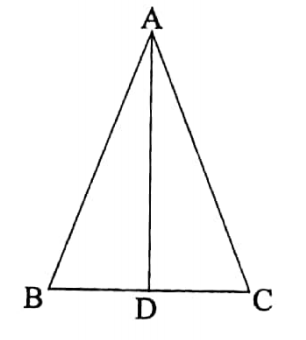
Construction: The bisector \(\overline{A D}\) of ∠BAC is drawn which intersects \(\overline{B C}\) at point D.
Proof: In the triangles ΔABD and ΔACD, ∠ABD = ∠ACD, ∠BAD = ∠CAD, and \(\overline{A D}\) are common.
∴ ΔABD = ΔACD
∴ \(\overline{A B}\) = \(\overline{A C}\).
Verification of Theorem-10 :
Construct a triangleΔABC in which ∠ACB = ∠ABC.
Measure the lengths of the sides \(\overline{A B}\) and \(\overline{A C}\) with a ruler.
You will find that, their lengths are the same.
Example 1
The side \(\overline{A C}\) of the triangle ABC has produced upto the point D so that \(\overline{C D}\) =\(\overline{C B}\). If the value of ∠ACB is 70° then what is the value of ∠ADB?
Solution:
Given
The side \(\overline{A C}\) of the triangle ABC has produced upto the point D so that \(\overline{C D}\) =\(\overline{C B}\).
Since ∠ACB is the exterior angle of the A BCD
∴ ∠ACB = ∠CDB + ∠CBD
Again since, CD = CB
∴ ∠CDB = ∠CBD
∴ ∠ACB = ∠CDB + ∠CBD
=2∠CDB
or, ∠CDB = 1/2 ∠ACB
= 1/2 x 70º
= 35º
∴ ∠ADB = 35º
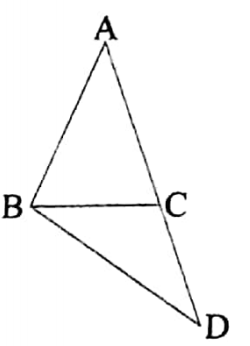
Example 2
Side \(\overline{A B}\) of the rhombus ΔBCD is 4 cm in length and ∠BCD = 60°; what is the length of \(\overline{B D}\)?
Solution :
Given:
Side \(\overline{A B}\) of the rhombus ΔBCD is 4 cm in length and ∠BCD = 60°
∠BCD = 60°
Also since ABCD is a rhombus
BC = CD
∠CBD = ∠CDB
But ∠CBD + ∠CDB = 180° – 60°
= 120° [ ∠BCD = 60°]
Hence, ∠CBD = ∠CDB = 60°
∴ ABCD is an equilateral triangle
∴ BD = CD = AB
= 4 cm. [since the sides of a rhombus are equal.]
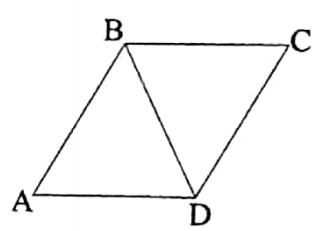
Example 3
PQR is an isosceles triangle in which \(\overline{P Q}\) = \(\overline{P R}\). The sides PQ and pp are produced to the points S and T respectively. Prove that, ∠RQS = ∠QRT and they are obtuse angles.
Solution :
Given:
PQR is an isosceles triangle in which \(\overline{P Q}\) = \(\overline{P R}\). The sides PQ and pp are produced to the points S and T respectively.
It is given that ΔPQR is an isosceles triangle in which
PQ = PR. PQ and
PR is produced to the points S and T respectively.
It is required to prove that:
1. ∠RQS – ∠QRT and
2. ∠RQS and ∠QRT are obtuse angles.
Proof :
1. In the ΔPQR,
since PQ = PR ∠PQR = ∠PRQ
Now,∠RQS = 180° – ∠PQR
= 180° – ∠PRQ = ∠QRT Hence, ∠RQS = ∠QRT.
2. PQR being a triangle, the sum of its three angles = 2 right angles.
So, ∠PQR + ∠PRQ is less than 2 right
angles. Also, as \(\overline{P Q}\) = \(\overline{P R}\).
∠PQR = ∠PRQ.
Hence, each of ∠PQR and ∠PRQ is less than 1 right angle.
Hence, their supplementary angles are greater than 1 right angle.
∴ ∠RQS and ∠QRT are obtuse angles.
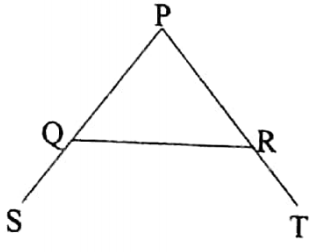
Example 4
Each side of an equilateral triangle PQR is 8 cm. The midpoints of \(\overline{P Q}\) and \(\overline{P R}\) are S and T respectively. What is the length of \(\overline{S T}\)?
Solution :
Given:
Each side of an equilateral triangle PQR is 8 cm. The midpoints of \(\overline{P Q}\) and \(\overline{P R}\) are S and T respectively.
ΔPQR is an equilateral triangle in which the midpoints of \(\overline{P Q}\) and \(\overline{P R}\) are S and T respectively.
∴ \(\overline{P S}\) = 1/2 \(\overline{P Q}\)
= 1/2 \(\overline{P R}\) = \(\overline{P T}\)
∠PST = ∠PTS.
also since ΔPQR is equilateral
∴ ∠SPT = 60°
∴ ∠PST + ∠PTS = 180º – 60º
= 120º
∴ ∠PST = ∠PTS = 60º
∴ APST is equilateral.
\(\overline{S T}\) = \(\overline{P S}\)
= 1/2 \(\overline{P Q}\)
= 1/2 x 8 cm
= 4cm.
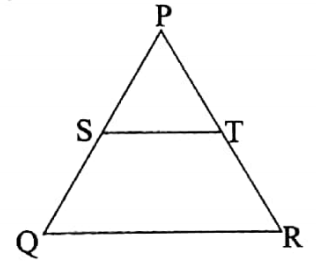
Example 5
ΔPQR is an isosceles triangle in which \(\overline{P Q}\) =\(\overline{P R}\). \(\overline{Q S}\) and rt are drawn perpendiculars from Q and R on \(\overline{P R}\) and \(\overline{P Q}\) respectively. If \(\overline{Q S}\) and RT intersect at O then prove that ΔOQR is isosceles.
Solution :
Given:
ΔPQR is an isosceles triangle in which \(\overline{P Q}\) = \(\overline{P R}\). \(\overline{Q S}\) is drawn perpendicular to \(\overline{P R}\) and
\(\overline{R T}\) is drawn perpendicular to \(\overline{P Q}\)
\(\overline{Q S}\) and \(\overline{R T}\) intersect at O.
It is required to prove that, ΔOQR is isosceles.
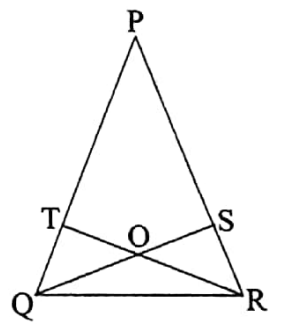
Proof: Since, ∠QSR = 90°
∴ ∠SRQ + ∠SQR = 90° ……. (1)
Also since, ∠RTQ = 90°
∴ ∠TQR + ∠TRQ =90° …….. (2)
From (1) and (2) we get,
∠SRQ + SQR = ∠TQR + ∠TRQ (3)
Also since, \(\overline{P Q}\) = \(\overline{P R}\)
:.∠PRQ =∠PQR
i.e., ∠SRQ =∠TQR.
Hence, from (3) ∠SQR = ∠TRQ,
i.e., ∠OQR = ∠ORQ
Hence, \(\overline{O R}\) = \(\overline{O Q}\)
ΔOQR is isosceles.
Key Terms Related to Geometry Theorems
Example 6
O is a point inside the triangle ABC, such that OA=OB=OC. Prove that ∠BOC = 2 ∠B AC.
Solution :
Given:
O is a point inside the triangle ABC, such that OA=OB=OC.
ABC is a triangle.
O is a point inside the triangle ABC such that \(\overline{O A}\) = \(\overline{O B}\) = \(\overline{O C}\).
It is required to prove that, ∠BOC = 2 ∠BAC.
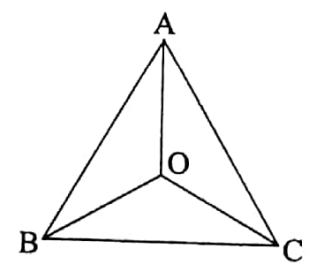
Proof: InΔAOB, OA = OB
:. ∠OAB = ∠OBA
∠AOB = 180° – (∠OAB + ∠OBA)
= 180° – 2∠OAB ….(1)
Also inΔAOC, OA = OC
∠OAC = ∠OCA
∠AOC = 180° – (∠OAC + ∠OCA)
= 180° – 2∠OAC ….(2)
Adding (1) and (2) we get,
∠AOB + ∠AOC = 360° – 2(∠OAB + ∠OAC)
or, 360° – ∠BOC = 360° – 2∠BAC
or, ∠BOC = 2∠BAC.
Example 7
Prove that the medians of an equilateral triangle are all equal.
Solution :
Let ABC be an equilateral triangle.
Let \(\overline{A D}\), \(\overline{B E}\), and \(\overline{C F}\) be its three medians.
It is required to prove that: \(\overline{A D}\) = \(\overline{B E}\) = \(\overline{C F}\).
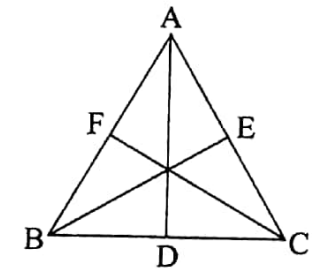
Proof: Since ΔABC is equilateral, therefore,
\(\overline{A B}\) = \(\overline{A C}\)
∴ 1/2 \(\overline{A B}\) = 1/2 \(\overline{A C}\)
∴ \(\overline{B F}\) = \(\overline{C E}\)
Now in the triangles, ΔFBC and ΔEBC
\(\overline{B F}\) = \(\overline{C E}\), \(\overline{B C}\) is common to both included ∠FBC = included ∠ECB
ΔFBC ≅ ΔEBC
\(\overline{B E}\) = \(\overline{C F}\) .…….. (1)
also, \(\overline{B C}\) = \(\overline{A B}\)
1/2 \(\overline{B C}\) = 1/2 \(\overline{A B}\)
\(\overline{C D}\) = \(\overline{A F}\)
Now in the triangles ΔADC and ΔAFC CD = AF, AC is common to both included ∠ACD = included ∠FAC
ΔADC ≅ ΔAFC
∴ \(\overline{A D}\) = \(\overline{A B}\) …….. (2)
From (1) and (2),
\(\overline{A D}\) = \(\overline{B E}\)= \(\overline{C F}\).
Example 8
A straight line is drawn through the vertex and parallel to the base of an isosceles triangle. Prove that, it will be the external bisector of the vertical angle.
Solution :
Given:
A straight line is drawn through the vertex and parallel to the base of an isosceles triangle.
Let ΔPQR be an isosceles triangle in which
\(\overline{P Q}\) = \(\overline{P Q}\).
\(\overrightarrow{P T}\) is drawn parallel to the base QR of ΔPQR. \(\overline{P Q}\) is produced to S.
It is required to prove that, \(\overrightarrow{P T}\) is the external bisector of ∠QPR
i.e., ∠SPT = ∠TPR.
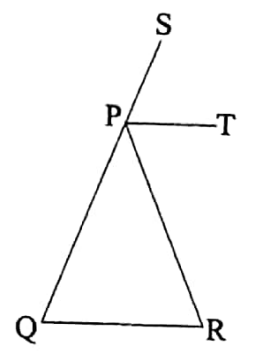
Proof: Since, \(\overrightarrow{P T}\) || \(\overrightarrow{Q R}\) and \(\overline{P R}\) is the transversal
∴ ∠TPR = alternate ∠PRQ
also, \(\overrightarrow{P T}\) || \(\overline{Q R}\) and \(\overline{S Q}\) are the transversal
∴ ∠SPT = corresponding∠PQR
Again, since \(\overline{P Q}\) = \(\overline{P R}\)
∠PQR = ∠PRQ
Hence, ∠SPT = ∠TPR.
Example 9
The Bisector of ∠BAC of ΔABC and the straight line through the midpoint D of the side AC and parallel to the side AB meet at a point E, outside BC. Prove that, ∠AEC = 1 right angle.
Solution :
Given:
The Bisector of ∠BAC of ΔABC and the straight line through the midpoint D of the side AC and parallel to the side AB meet at point E, outside BC.
EC is joined.
It is required to prove that, ∠AEC = 1 right angle.
Proof: ∠BAE = ∠EAC.
Again, ∠DEA = ∠BAE = ∠EAD
[ AB || DE, AE is the transversal
∠DEA = alternate ∠BAE ]
AD = DE. But AD – DC DE = DC
:. ∠DEC = ∠DCE,
Now, ∠AED + ∠DEC = ∠DAE + ∠DC
or, ∠AEC = ∠CAE + ∠ACE
or, ∠AEC + ∠AEC = ∠AEC + ∠CAE + ∠ACE
or, 2 ∠AEC = 180°
or, ∠AEC = 90° = 1 right angle. (Proved)
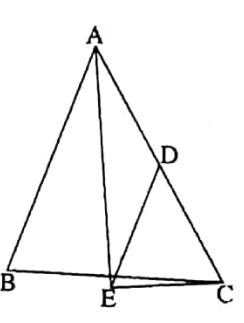
Theorem 11
If one side and the two angles at the extremities of a triangle be equal to one side and the two angles at the extremities of another triangle then the two triangles are congruent.
Let ΔABC and ADEF be the two. triangles in which \(\overline{B C}\) = \(\overline{E F}\),
∠ABC – ∠DEF and ∠ACB = ∠DFE.
It is required to prove that,ΔABC = ΔDEF.
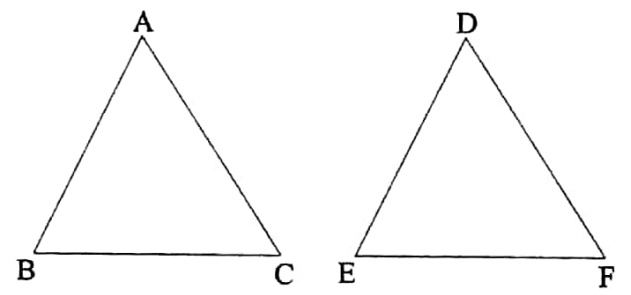
Proof: Keeping the sides BC and EF of the triangles ABC and DEF on the same horizontal line with the vertices A and D upwards and giving ΔABC a translation of measure AD we find that the points A, B, and C respectively coincide with the points D, E, and F and the sides AB, BC, and CA respectively coincide with the sides DE, EF, and FD.
Hence, ΔABC = ΔDEF.
Theorem 12
If the hypotenuse and the side of one right-angled triangle be equal to the hypotenuse and the corresponding side of another right-angled triangle, the two triangles will be congruent.
Let ∠ACB and ∠DFE of the right-angled triangles ΔABC andΔDEF be right angles.
Let hypotenuse \(\overline{A B}\) = hypotenuse \(\overline{D E}\) and side \(\overline{A C}\) = side \(\overline{D F}\).
It is required to prove that, ΔABC ≅ ΔDEF.
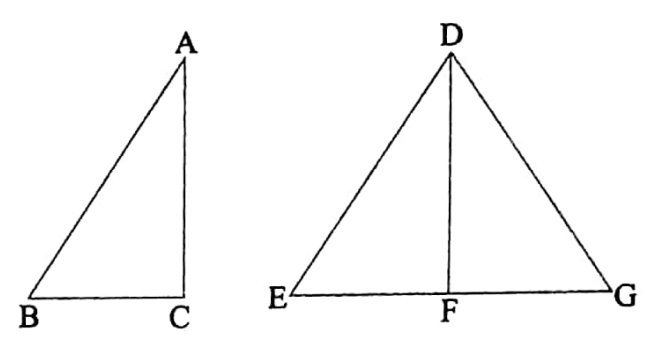
Proof: Place ΔABC on ΔDEF in such a way that, point A coincides with point D, side \(\overline{A C}\)coincides with side \(\overline{D F}\) and point B falls on G which is on that side of \(\overline{D F}\) opposite to E.
Here point C will coincide with F because \(\overline{A C}\) = \(\overline{D F}\)
Thus, ΔDGF is the new position of ΔABC.
Since both ∠DFE and ∠DFG are right angles therefore EFG is a straight line and DEG is a triangle.
Now, \(\overline{D E}\) = \(\overline{A B}\) = \(\overline{D G}\)
∠DEF= ∠DGF = ∠ABC.
Now, in the triangles, ΔABC and ΔDEF,
∠ACB = ∠DFE, ∠ABC = ∠DEF and AC = DF
Hence, ΔABC ≅ ΔDEF.
Alternative proof:
Keeping the sides BC and EF of the triangles ABC and DEF on the same horizontal line with the vertices A and D upwards and giving ΔABC a translation of measure AD we find that the points A, B, and C respectively coincide with the points D, E, and F and the sides AB, BC, and CA respectively coincide with the sides DE, EF and FD.
Hence, ΔABC ≅ΔDEF.
Some Examples
Example 1
ABCD is a quadrilateral in which \(\overline{A B}\) = \(\overline{A D}\) and \(\overline{B C}\)= \(\overline{D C}\). Prove that, the diagonal \(\overline{A C}\) of the quadrilateral ΔBCD bisects the other diagonal \(\overline{B D}\) at right angles.
Solution :
Given:
ABCD is quadrilateral in which \(\overline{A B}\) = \(\overline{A D}\)
and \(\overline{B C}\) = \(\overline{D C}\). Let the diagonals AC and
\(\overline{B D}\) of the quadrilateral ABCD intersects each other at point O.
It is required to prove that AC bisects
\(\overline{B D}\) at right angles.
\(\overline{A B}\) = \(\overline{A D}\) , \(\overline{B C}\) = \(\overline{D C}\) and \(\overline{A C}\) is common to both
ΔABC = ΔADC
Hence, ∠BAC ≅ ∠DAC
i.e., ∠BAO = ∠DAO.
Also in the triangles ABO and ADO,
\(\overline{A B}\) = \(\overline{A D}\), \(\overline{A O}\) is common and included ∠BAO = included ∠DAO.
Hence, AΔBOA = ΔDOA.
So, \(\overline{B O}\) = \(\overline{O D}\) and ∠AOB = ∠AOD.
But ∠AOB and ∠AOD are the adjacent angles on the same straight line BD and therefore each of them is equal to 1 right angle.
\(\overline{B D}\) ⊥ \(\overline{A C}\)
Hence, \(\overline{A C}\), bisects \(\overline{B D}\) at right angles.
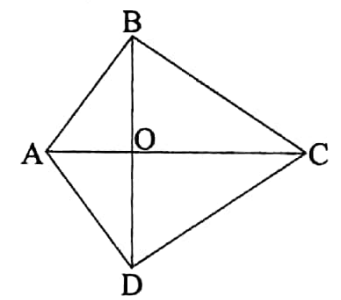
Example 2
Prove that the line segment joining the vertical angle of an isosceles triangle with the midpoint of the base bisects the vertical angle and is perpendicular to the base.
Solution :
Let ABC be an isosceles triangle in which \(\overline{A B}\) = \(\overline{A C}\).
Let D be the mid point of the side \(\overline{B C}\) of ΔABC.
Let us join \(\overline{A D}\).
It is required to prove that, \(\overline{A D}\) bisects ∠BAC and \(\overline{A D}\) ⊥ \(\overline{B C}\)
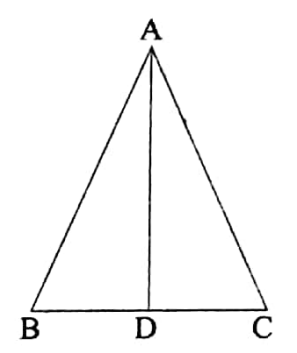
Proof: In the triangles ABD and ACD
\(\overline{A B}\) = \(\overline{A C}\), AD is common, and \(\overline{B D}\)= \(\overline{D C}\)
Hence, ΔABD = ΔACD
∴ ∠BAD = ∠CAD
which means that AD bisects ∠BAC and also, ∠ADB = ∠ADC,
but ∠ADB and ∠ADC are adjacent angles on the same
straight line \(\overline{B C}\) and therefore each of them is equal to 1 right angle.
It proves that AD ⊥ BC.
Example 3
Points A, B, and C are taken on a circle in such a way that \(\overline{A B}\) = \(\overline{B C}\). If 0 is the center of the circle then prove that OB is the bisector of ∠AOC.
Solution :
A, B, and C are three points on a circle having its center at O such that \(\overline{A B}\) = \(\overline{B C}\).
OB is joined.
It is required to prove that, OB is the bisector of ∠AOC.
Proof: In the triangles AOB and BOC,
AB = BC, AO = OC (both being equal to the radius of the circle), and \(\overline{O B}\) is common.
Hence, ΔAOB = ΔBOC
:. ∠AOB = ∠COB.
Hence, \(\overline{O B}\) is the bisector of ∠AOC.
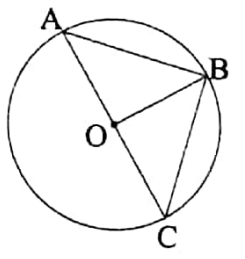
Example 4
Prove that, the diagonals of a rhombus bisect each other at right angles.
Solution :
Let ABCD be a rhombus in which the two diagonals \(\overline{A C}\) and \(\overline{B D}\) intersect each other at O.
It is required to prove that, \(\overline{A C}\) and \(\overline{B D}\) bisect each other at right angles.
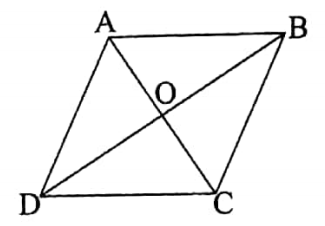
Proof: In the triangles ADC and ABC,
AD = AB, DC = BC, and AC is a common ΔADC ≅ ΔABC
∠DAC = ∠BAC.
Also in the triangles ADO and ABO AD = AB, AO is common and included ∠DAO = included ∠BAO
:. ΔAOD = ΔAOB
:. OD = OB and ∠AOD = ∠AOB.
But ∠AOD and ∠AOB are two adjacent angles on the same straight line DB and hence each of them is equal to 1 right angle.
∴ AO ⊥ BD.
Hence, it is proved that \(\overline{B D}\) is bisected at right angles by \(\overline{A C}\) Similarly, it can be shown that \(\overline{A C}\) is bisected at right angles by \(\overline{B D}\)
Example 5
Prove that, the perpendicular drawn from the vertex of an isosceles triangle to the base bisects the base and the vertical angle.
Solution:
Let ABC be an isosceles triangle in which AB = \(\overline{A C}\).
Let \(\overline{A D}\) be drawn perpendicular to \(\overline{B C}\)
It is required to prove that,
∠BAD = ∠CAD and \(\overline{B D}\) = \(\overline{C D}\).
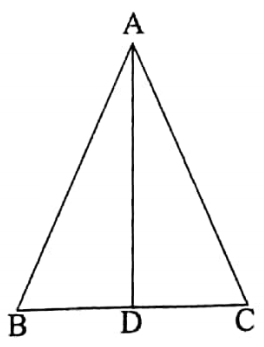
Proof: In the right-angled triangles,
ABD and ACD, hypotenuse \(\overline{A B}\) = hypotenuse \(\overline{A C}\)
AD is common in both ΔABD = ΔACD
∠BAD = ∠CAD and \(\overline{B D}\) = \(\overline{C D}\).
Example 6
PQR is a triangle. \(\overline{Q S}\) and \(\overline{R T}\) are drawn perpendiculars from Q and R on PR and PQ respectively. If \(\overline{Q S}\) = \(\overline{R T}\) then prove that, \(\overline{P Q}\) = \(\overline{P R}\).
Solution:
Given:
PQR is a triangle \(\overline{Q S}\) and \(\overline{R T}\) are drawn
perpendiculars from Q and R on PR and
\(\overline{P Q}\)respectively.
Also \(\overline{Q S}\) = \(\overline{R T}\)
It is required to prove that,
\(\overline{P Q}\) = \(\overline{P R}\).
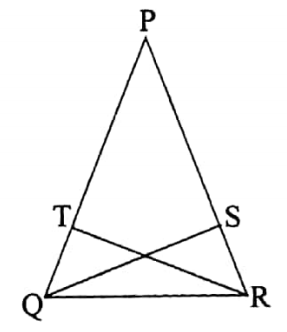
Proof: In the right-angled triangles QSR and QTR,
\(\overline{Q S}\) = \(\overline{R T}\), \(\overline{Q R}\) is the common hypotenuse
∴ Δ QSR = Δ QTR
:. ∠SRQ = ∠TQR
i.e., ∠PRQ = ∠PQR
Hence, PQ = PR.
Example 7
O is a point within ∠PQR. Two perpendiculars \(\overline{Q S}\) and \(\overline{O T}\) are drawn on \(\overline{P Q}\) and \(\overline{Q R}\)– respectively. If \(\overline{O S}\) = \(\overline{O T}\) then proves that, ∠OQS = ∠OQT.
Solution :
Given:
O is a point in the angular region of ∠PQR.
From O, two perpendiculars \(\overline{O S}\) and \(\overline{O T}\) are drawn on \(\overline{P Q}\) and \(\overline{Q R}\) Respectively.
It is given that \(\overline{O S}\) = \(\overline{O T}\). \(\overline{Q O}\) is joined.
It is required to prove that, ∠OQS – ∠OQT.
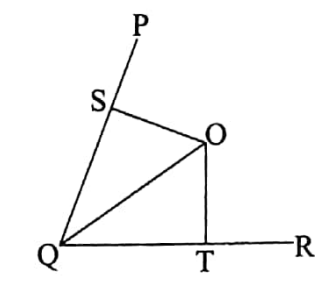
Proof: According to the given conditions both ΔQOS and ΔQOT are right-angled triangles.
Now in the right-angled triangles, ΔQOS and ΔQOT
\(\overline{O S}\) = \(\overline{O T}\). \(\overline{Q O}\) is the common hypotenuse ΔQOS = ΔQOT
∠OQS = ∠OQT.
Example 8
Prove that, in a right-angled triangle the line segment joining the right angular point to the midpoint of the hypotenuse is half of the hypotenuse.
Solution :
Let ΔABC be a right-angled triangle of which ∠ABC = 1 right angle.
Let O be the midpoint of the hypotenuse \(\overline{A C}\).
It is required to prove that, \(\overline{B O}\) = 1/2\(\overline{A C}\)
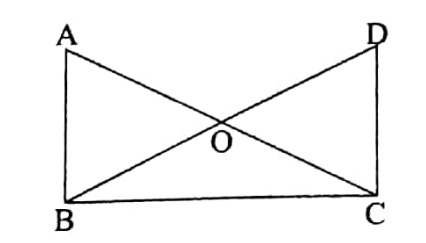
Construction: \(\overline{B O}\) is joined and extended upto the point D in such a way that
\(\overline{B O}\) = \(\overline{O D}\). \(\overline{C D}\) is joined.
Proof: In the triangles AOB and COD,
\(\overline{A O}\) = \(\overline{O C}\), \(\overline{B O}\)= \(\overline{O D}\), and ∠AOB = vertically opposite ∠COD.
ΔAOB ≅ ΔCOD
AB = CD and ∠ABO = ∠CDO but they are alternate angles AB || DC.
Also since AB X BC CD T BC
∠DCB = 1 right angle and hence ABCD is a right-angled triangle.
Now, in the right-angled triangles, ΔABC and ΔDBC
\(\overline{A B}\) = \(\overline{C D}\), \(\overline{B C}\) is common to both included ∠ABC = included ∠DCB (both equal to 90°)
∴ ΔABC ≅ ΔDCB
\(\overline{A C}\) = \(\overline{B D}\) = 2\(\overline{B O}\)
:. \(\overline{B O}\) = 1/2 \(\overline{A C}\).
Theorem 13
If two sides of a triangle are unequal, the angle opposite to the greater side is greater than the angle opposite to the less.
Let ΔABC be a triangle in which \(\overline{A B}\) > \(\overline{A C}\).
It is required to prove that: ∠ACB > ∠ABC.
Construction: From \(\overline{A B}\), the segment \(\overline{A D}\) equal to\(\overline{A C}\) is cut off.
Let us join \(\overline{C D}\).
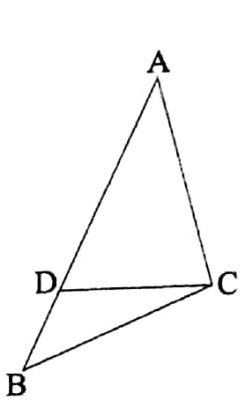
Proof: In the ΔACD,
since AC = AD, therefore, ∠ADC = ∠ACD.
Now, in ΔBCD,
∠ADC is the exterior angle and ∠DBC is the interior opposite angle.
:. ∠ADC > ∠DBC
i.e., ∠ADC > ∠ABC
Or, ∠ACD > ∠ABC [ ∠ADC = ∠ACD] H
ence, ∠ACB > ∠ABC [∴ ∠ACB > ∠ACD].
Verification of Theorem-13 :
On your paper draw any triangle ABC in such a way that the side \(\overline{A B}\) > side \(\overline{A C}\)
Then measure the angles ∠ACB and ∠ABC with a protractor.
You will find that ∠ACB > ∠ABC.
Theorem 14
If two angles of a triangle are unequal, the side opposite to the greater angle is greater than the side opposite to the less.
Let ΔABC be a triangle in which ∠ACB > ∠ABC.
It is required to prove that, \(\overline{A B}\) > \(\overline{A C}\)
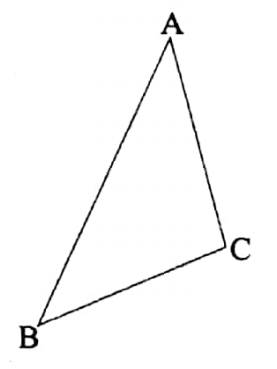
Proof: If \(\overline{A B}\) = \(\overline{A C}\) then ∠ACB = ∠ABC. But it is not true according to the hypothesis.
If \(\overline{A B}\) < \(\overline{A C}\) then ∠ACB < ∠ABC. But it is also not true according to the hypothesis.
So, AB is neither equal to nor less than \(\overline{A C}\).
Hence, the only possibility is that \(\overline{A B}\) > \(\overline{A C}\)
Verification of Theorem-14 :
On your paper draw any triangle ABC in such a way that ∠ACB >∠ABC.
Then measure the sides \(\overline{A B}\) and \(\overline{A C}\) with a ruler.
You will find that \(\overline{A B}\) > \(\overline{A C}\).
Theorem 16
Any two sides of a triangle are together greater than the third side.
Let ABC be a triangle
It is required to prove that, any two sides of ΔABC are together greater than the third side.
Let \(\overline{B C}\) be the greatest side of the ΔABC.
So it will be sufficient to prove that, \(\overline{A B}\) + \(\overline{A C}\) > \(\overline{B C}\).
Construction: The side \(\overline{B A}\) of the ΔABC is produced to D in such a way that \(\overline{A D}\) = \(\overline{A C}\) Let us join \(\overline{C D}\).
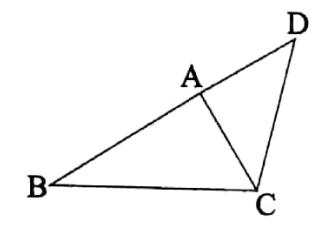
Proof: In ΔACD, since \(\overline{A D}\) = \(\overline{A C}\) according to construction, therefore, ∠ACD = ∠ADC.
Now, ∠BCD = ∠BCA + ∠ACD > ∠ADC,
i.e., ∠BCD > ∠BDC
Hence, in the ABCD since ∠BCD > ∠BDC therefore,
\(\overline{B D}\) > \(\overline{B C}\)-.
or,\(\overline{A B}\) + \(\overline{A D}\) >\(\overline{B C}\)
or, \(\overline{A B}\) + \(\overline{A C}\)– > \(\overline{B C}\)– [ AD = AC]
Verification of Theorem – 15:
in such a way that \(\overline{B C}\) is the greatest side.
Then measure the lengths of sides \(\overline{A B}\), \(\overline{A C}\), and \(\overline{B C}\)
You will find that \(\overline{A B}\) + \(\overline{A C}\) > \(\overline{B C}\)
Theorem 16
Of all line segments that can be drawn to a given straight line from a given point outside it, the perpendicular is the shortest.
Let \(\overline{A B}\) be any straight line, and O be a point outside it. From O, a line
segment \(\overline{P Q}\) is drawn which is O
perpendicular to \(\overline{A B}\) It is required to prove that, of all other line segments that can be drawn
from point O to the straight line \(\overline{A B}\), \(\overline{O P}\) is the shortest.
Construction: Let us take any point Q on the straight line \(\overline{A B}\) Let us join \(\overline{O Q}\).
Proof: In the ΔOPQ, ∠OPQ is a right angle and ∠OQP is an acute angle.
.’. ∠OQP < ∠OPQ and hence \(\overline{O P}\) < \(\overline{O Q}\).
Since this conclusion is true for any position of Q on \(\overline{A B}\), therefore the length of \(\overline{O P}\) is the shortest.
Verification of Theorem-16 :
Take any straight line \(\overline{A B}\). From a
point O outside \(\overline{A B}\) draw a
perpendicular \(\overline{O P}\) and any other line
segment \(\overline{O Q}\). You will find that \(\overline{O P}\) < \(\overline{O Q}\)
Since it is true for any position of Q on \(\overline{A B}\), therefore the theorem is verified.
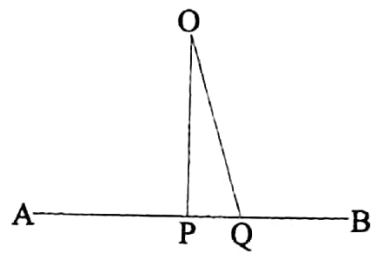
Some Examples
Example 1
Prove that, the sum of any three sides of a quadrilateral is greater than the fourth side.
Solution :
Let ABCD be a quadrilateral.
It is required to prove that, the sum of any three sides of ABCD is greater than the fourth side.
If \(\overline{D C}\) is the greatest side then it is sufficient to prove that, \(\overline{A D}\) + \(\overline{A B}\)+ \(\overline{B C}\) >
\(\overline{D C}\)
Construction: Let us join BD.
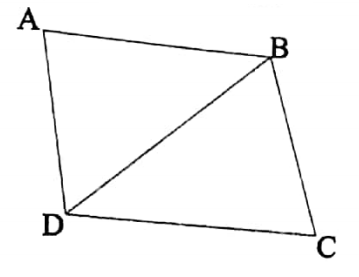
Proof: In the ADAB
\(\overline{A D}\) + \(\overline{A B}\) >\(\overline{D B}\) ……(1)
Also in the ADBC
\(\overline{D B}\) +\(\overline{B C}\) > \(\overline{D C}\) …..(2)
From (1) and (2)
\(\overline{A D}\) + A\(\overline{A B}\)+\(\overline{D B}\) + \(\overline{B C}\)>\(\overline{D B}\) + \(\overline{D C}\) Subtracting equal quantity \(\overline{D B}\)
From both sides, we get, \(\overline{A D}\) + \(\overline{A B}\) +\(\overline{B C}\) > \(\overline{D C}\).
Example 2
Prove that, the hypotenuse is the greatest side of a right-angled triangle.
Solution :
Let ABC be a right-angled triangle in
which ∠ABC = 90°.
Hence, AC is the hypotenuse ofΔABC.
It is required to prove that, AC is the greatest side of ΔABC.
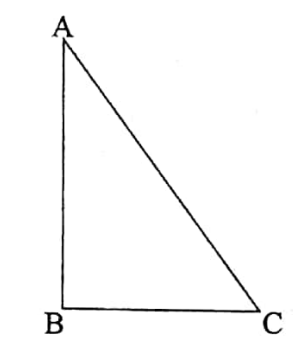
Proof: Since, ∠ABC – 90°
∴ ∠BAC + ∠BCA = 90°.
Hence, each of ∠BAC and ∠BCA is less than 90°.
Now, since, ∠ABC > ∠BAC
:. AC > BC (1)
also since ∠ABC > ∠ACB
\(\overline{A C}\) > \(\overline{A B}\) (2)
From (1) and (2) it follows that,
\(\overline{A C}\) is the greatest side of the ΔABC.
Example 3
The sides \(\overline{A B}\) and \(\overline{A D}\) of the isosceles triangle ABD are equal. The side \(\overline{ADB}\) is extended upto the point C and points B and C are joined. Prove that, ∠ABC > ∠ACB.
Solution :
Given:
The sides \(\overline{A B}\) and \(\overline{A D}\)– of the isosceles triangle ABD is equal. The side \(\overline{A D}\) is
extended up to the point C. \(\overline{B C}\) is joined.
It is required to prove that, ∠ABC > ∠ACB.
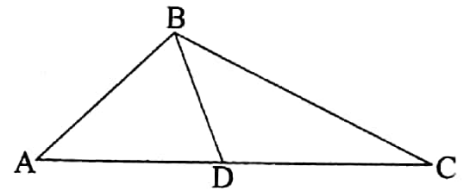
Proof: In the ABCD, since ∠ADB is the exterior angle, therefore, ∠ADB > ∠DCB.
But since AB = AD ∠ADB = ∠ABD
Hence, ∠ABD > ∠DCB
also since ∠ABC > ∠ABD = ∠ABC > ∠DCB
i.e., ∠ABC > ∠ACB.
Example 4
In the triangle PQR. the side PQ is greater than the side \(\overline{P S}\).\(\overline{P S}\) is the bisector of ∠QPR which intersects \(\overline{Q B}\) at S. Prove that \(\overline{Q S}\)>\(\overline{S R}\)
Solution:
Given:
In the ΔPQR,\(\overline{P Q}\) > \(\overline{P R}\). PS is the bisector of ∠QPR, which intersects \(\overline{Q R}\) at S.
It is required to prove that, \(\overline{Q S}\) > \(\overline{S R}\).
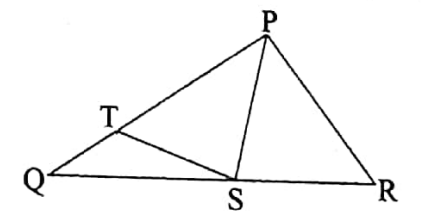
Construction: From\(\overline{P Q}\) let us cut off a portion \(\overline{P T}\) equal to \(\overline{P R}\).
Let us join \(\overline{S T}\).
Proof: In the triangles PTS and PRS
\(\overline{P T}\) = \(\overline{P R}\), PS is common and ∠SPT = ∠SPR
APTS ≅ APRS.
\(\overline{S T}\) = \(\overline{S R}\) and∠PST = ∠PSP
In the APQS, since ∠PSP is an exterior angle.
∠PSR > ∠PQS
i.e., ∠PST > ∠PQS
Also in the ΔPST since ∠QTS is an exterior angle
∴ ∠QTS > ∠PST
∴ ∠QTS > ∠TQS
\(\overline{Q S}\) > \(\overline{S T}\)
But \(\overline{S T}\) > \(\overline{S R}\)
∴ \(\overline{Q S}\) >\(\overline{S R}\)
Example 5
ΔABC is an equilateral triangle. D is a point on \(\overline{A C}\). Prove that, \(\overline{B C}\)>\(\overline{B D}\).
Solution:
Given:
ΔABC is an equilateral triangle. D is a point on \(\overline{A C}\).
\(\overline{B D}\) is joined.
It is required to prove that, \(\overline{B C}\) > \(\overline{B D}\).
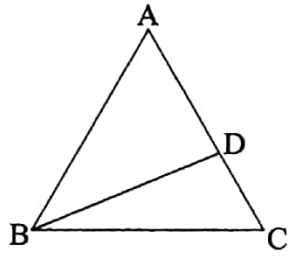
Proof: In the ΔABD, ∠BDC is the exterior angle,
∠BDC > ∠BAC
But since \(\overline{B C}\) = \(\overline{A B}\)
∠BAC = ∠BCA ∠BDC > ∠BCA
i.e., ∠BDC > ∠BCD
Hence, \(\overline{B C}\) > \(\overline{B D}\)
Example 6
D is a point within the triangle ABC. \(\overline{B D}\) and \(\overline{C D}\) are joined. Prove that, \(\overline{A B}\) + \(\overline{A C}\) >\(\overline{B D}\) + \(\overline{C D}\)
Solution :
Given:
D is a point within the triangle ABC. \(\overline{B D}\) and \(\overline{C D}\) are joined.
ABC is a triangle. D is a point within it.
BD and CD are joined.
It is required to prove that,
\(\overline{A B}\)+ \(\overline{A C}\) > \(\overline{B D}\) + \(\overline{C D}\)
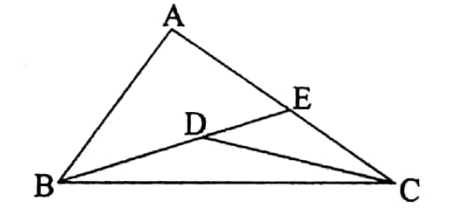
Construction: Produce BD to intersect AC at E.
Proof: In the ΔABE.
\(\overline{A B}\) +\(\overline{A B}\) > \(\overline{B E}\)
i.e., \(\overline{A B}\)+\(\overline{A E}\) > \(\overline{B D}\)+\(\overline{D E}\)-—(1)
Also in the ΔDEC,
\(\overline{D E}\) + \(\overline{E C}\) > \(\overline{C D}\)…….. (2)
Adding (1) and (2) we get,
\(\overline{A B}\) + \(\overline{A E}\) + \(\overline{D E}\) + \(\overline{E C}\) > \(\overline{B D}\) + \(\overline{D E}\) + \(\overline{C D}\)
or, \(\overline{A B}\) + \(\overline{A E}\) + \(\overline{E C}\) > \(\overline{B D}\) + \(\overline{C D}\)
or, \(\overline{A B}\) + \(\overline{A C}\) > \(\overline{B C}\) + \(\overline{C D}\).
Example 7
D is the midpoint of the side \(\overline{B C}\) of ΔABC. Prove that,\(\overline{A B}\) + \(\overline{A C}\)> 2 \(\overline{A D}\).
Solution:
Given:
D is the midpoint of the side \(\overline{B C}\) of ΔABC.
ABC is a triangle. D is the midpoint of \(\overline{B C}\)
\(\overline{A D}\) is joined.
It is required to prove that,
\(\overline{A B}\) + \(\overline{A C}\) > 2 \(\overline{A D}\).
Construction: \(\overline{A D}\) is produced upto the point H, such that \(\overline{A D}\) = \(\overline{D H}\).
Proof: In the ABD and CDH,
\(\overline{B D}\) = \(\overline{C D}\), \(\overline{A D}\) = \(\overline{D H}\)
and include ∠ADB = include ∠HDC (Since they are vertically opposite angles)
:. ΔABD ≅ ΔCDH
\(\overline{A B}\) = \(\overline{C H}\)
Now, in the ΔACH,
\(\overline{A C}\) + \(\overline{C H}\) > \(\overline{A H}\)
or, \(\overline{A C}\) + \(\overline{A B}\) > 2\(\overline{A D}\)
\(\overline{C H}\) = \(\overline{A B}\) and \(\overline{A H}\) = 2 \(\overline{A D}\)
AB + AC >2 \(\overline{A D}\).
Example 8
Prove that, in any triangle, the sum of the medians is less than the perimeter.
Solution:
Given:
In any triangle, the sum of the medians is less than the perimeter.
Let ABC be a triangle in which \(\overline{A D}\), \(\overline{B E}\), and \(\overline{C F}\) are three medians.
It is required to prove that,
\(\overline{A D}\) + \(\overline{B E}\) + \(\overline{C F}\) < \(\overline{A B}\) + \(\overline{B C}\) + \(\overline{C A}\)
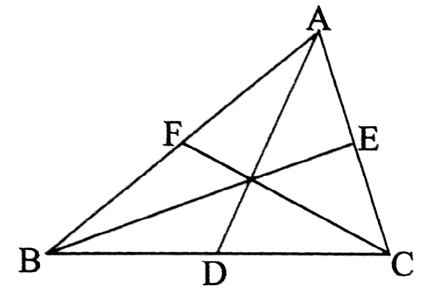
Proof:
Since, \(\overline{A D}\), \(\overline{B E}\) and \(\overline{C F}\) are the three medians of ΔABC
therefore,
\(\overline{A B}\) + \(\overline{A C}\) > 2 \(\overline{A D}\) …..(1)
\(\overline{A B}\) + \(\overline{B C}\) > 2 \(\overline{B F}\) …..(2)
\(\overline{B F}\) + \(\overline{C A}\) > 2 \(\overline{C F}\) …..(3)
Adding (1), (2) and (3) we get,
2 (\(\overline{A B}\) + \(\overline{B C}\) + \(\overline{C A}\)) > 2(\(\overline{A D}\) + \(\overline{B E}\) + \(\overline{C F}\))
or, \(\overline{A B}\) + \(\overline{B C}\) + \(\overline{C F}\) < \(\overline{A B}\) + \(\overline{B C}\) + \(\overline{C A}\).
Example 9
D is any on the extended side BC of the equilateral triangle ABC. Prove that, ∠BAD > ∠ADB.
Solution:
Given:
D is any point on the extended side BC of the equilateral triangle ABC. AD is joined.
It is required to prove that, ∠BAD > ∠ADB.
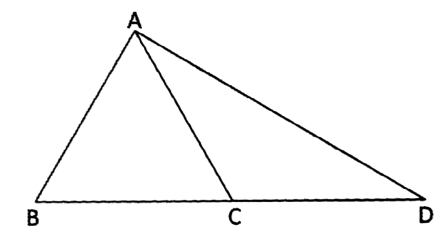
Proof: ABC is an equilateral triangle
∴ BC = AB
BD = BC + CD
∴ BD > AB ( BC = AB)
∴ in ΔABD, BD > AB
∴ ∠BAD > ∠ADB (proved).

